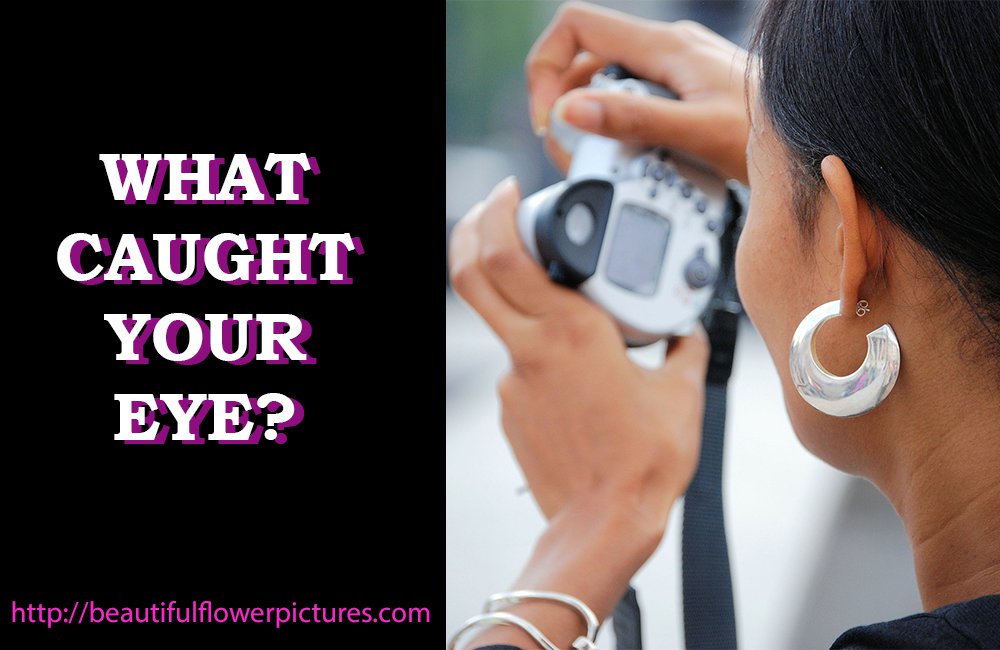
by hankinslawrenceimages | Jun 10, 2016 | Photo Tips
Thanks for the great response to my article about using a tripod. After my newsletter went out last week, I had a few people ask me what sorts of things I think about when I’m taking the time to set up my tripod. One of the main things I think about is what caught my eye? Or another way of looking at it is – why did I stop in this particular spot to take a photo – rather than 3 feet to the left or say 6 feet to the right? Something caught my and made me want to take a photo. While I’m setting up my tripod, I’m figuring out what that is – so I can take the photo I’m seeing in my mind.
Over the years, I’ve realized that there are several things that catch my eye and make me want to stop and take a photo.
Sometimes it’s a single perfect flower
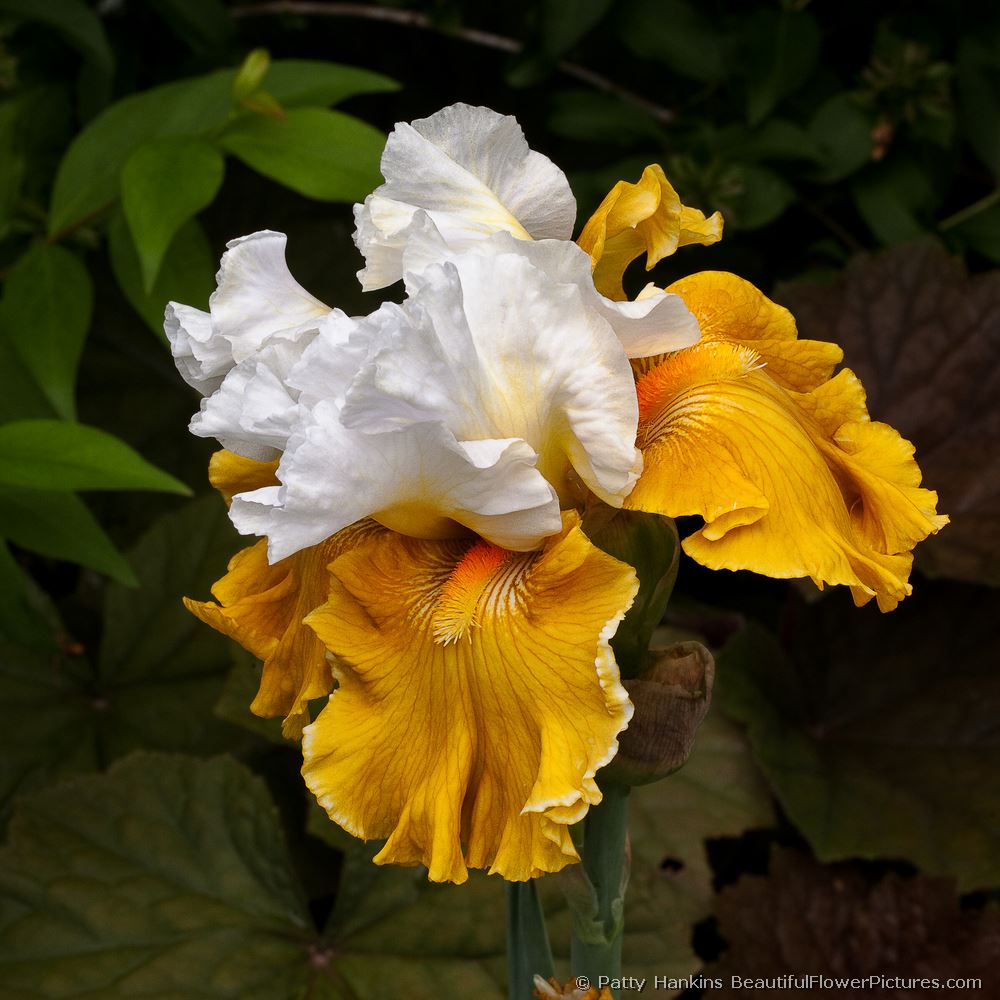
Tour de France Bearded Iris © 2010 Patty Hankins
Other times it’s a combination of flowers
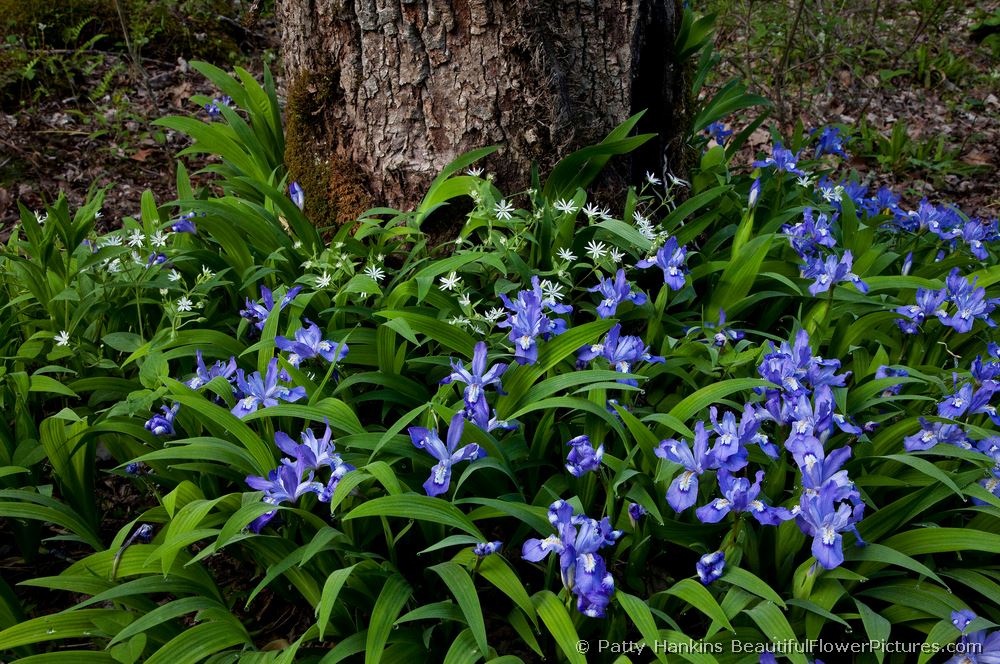
Crested Dwarf Iris & Star Chickweed © 2009 Patty Hankins
Or it could be several of the same flower
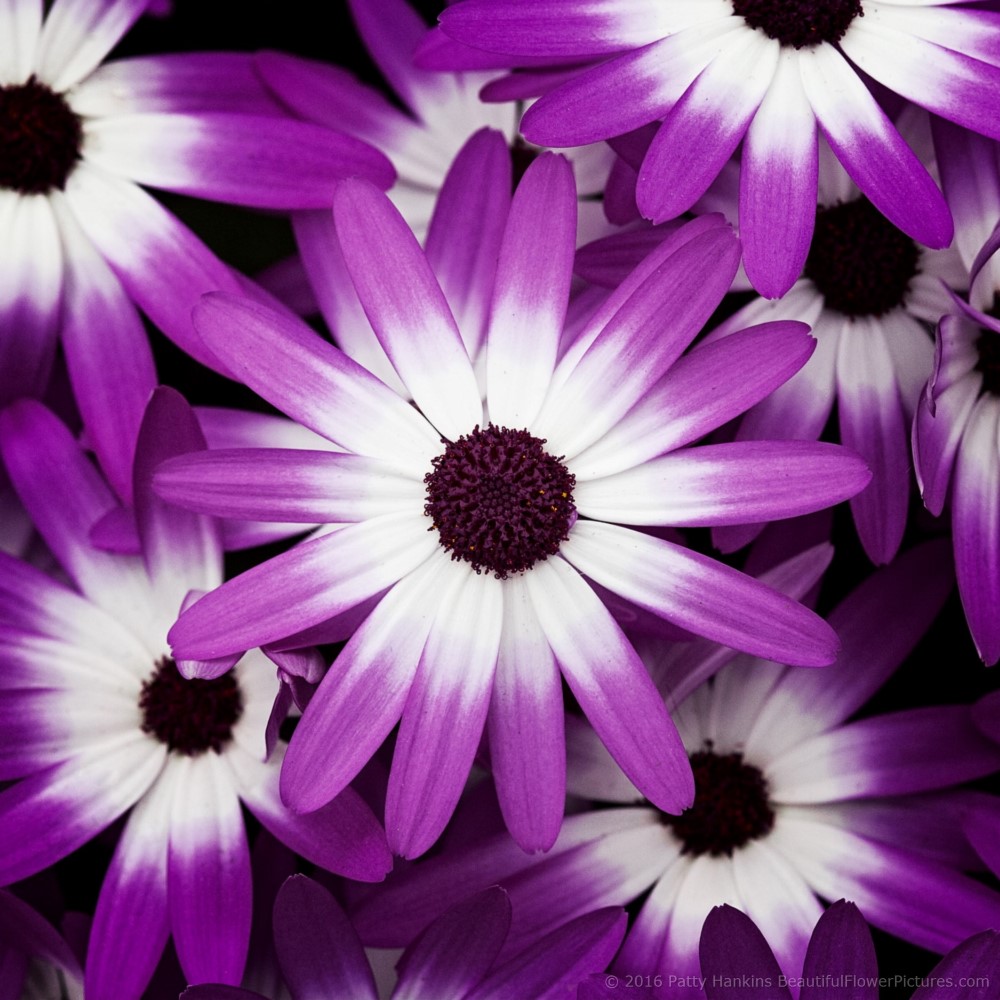
Sunserba Cineraria © 2016 Patty Hankins
Sometimes it’s a single color – like the shades of blue in these blue hydrangeas
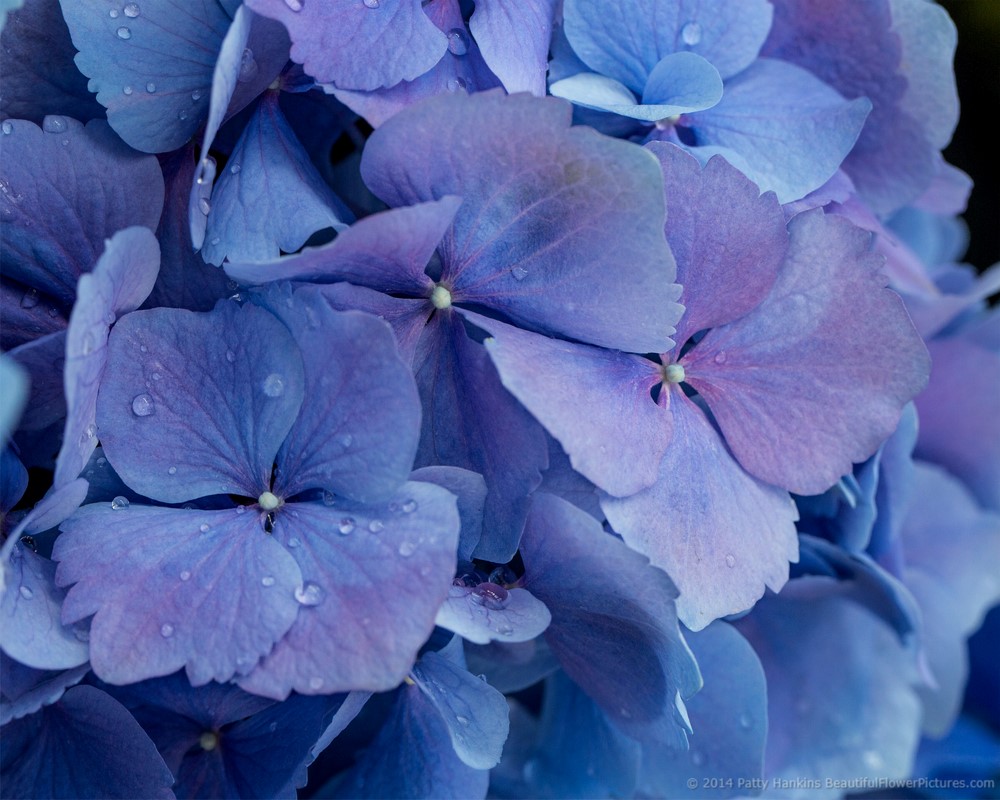
Blue Bigleaf Hydrangea Blossoms © 2014 Patty Hankins
Or it could be a combination of colors – like the purple and yellows in the wildflowers
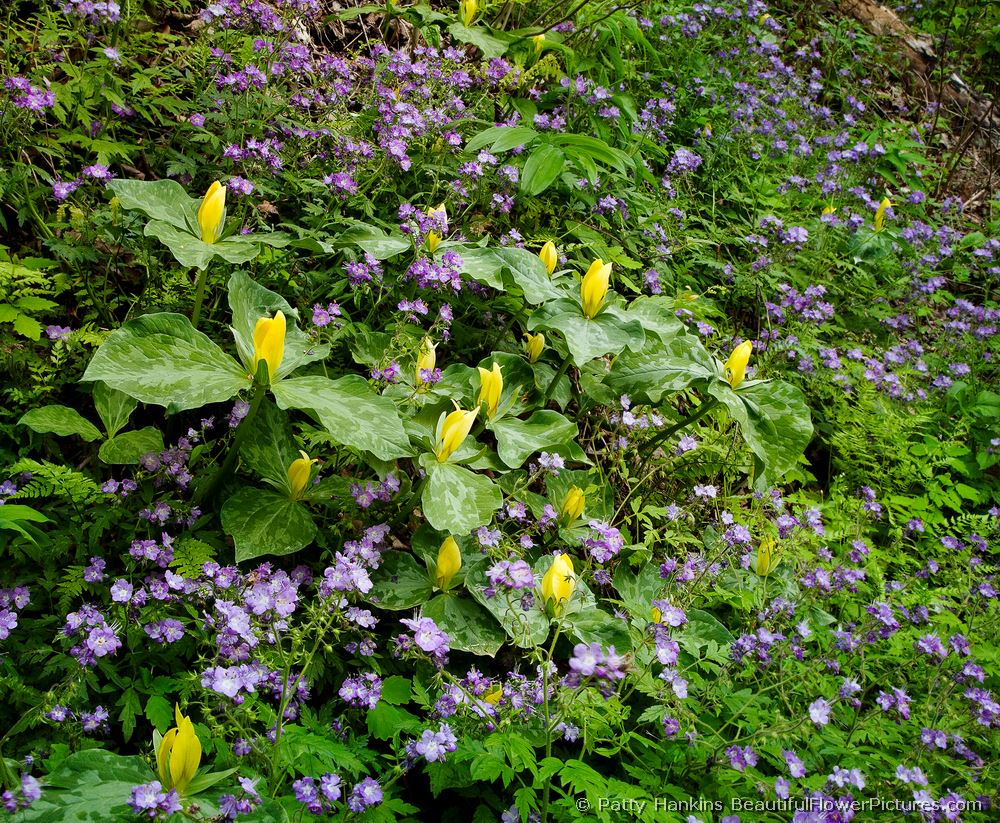
Yellow Trillium & Purple Phacelia © 2009 Patty Hankins
Sometime it’s the details – like the center of a sunflower
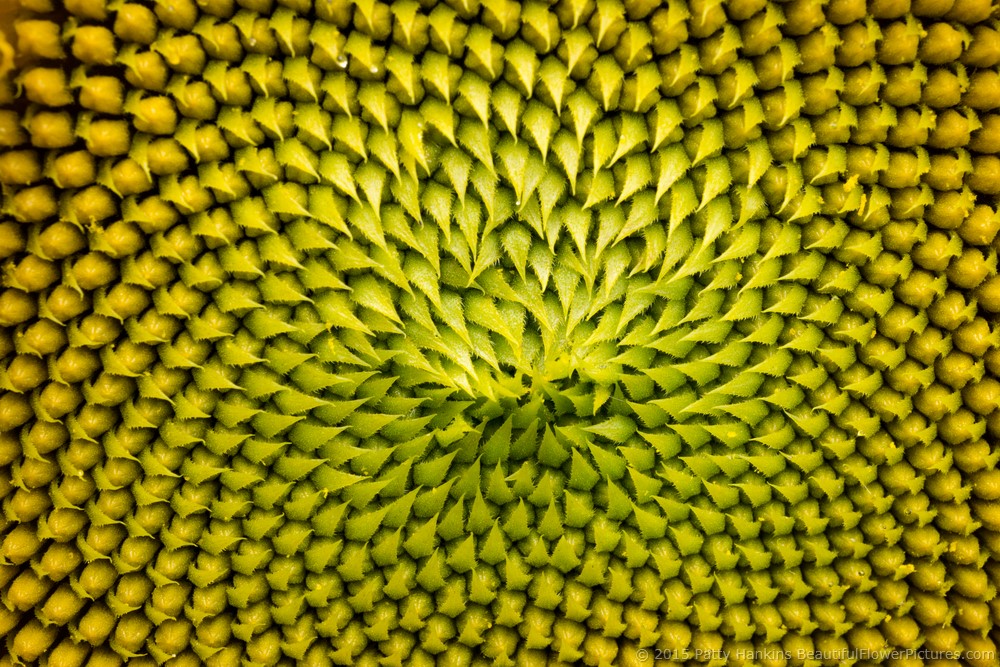
Sunflower © 2015 Patty Hankins
Or it can be the whole scene in front of me
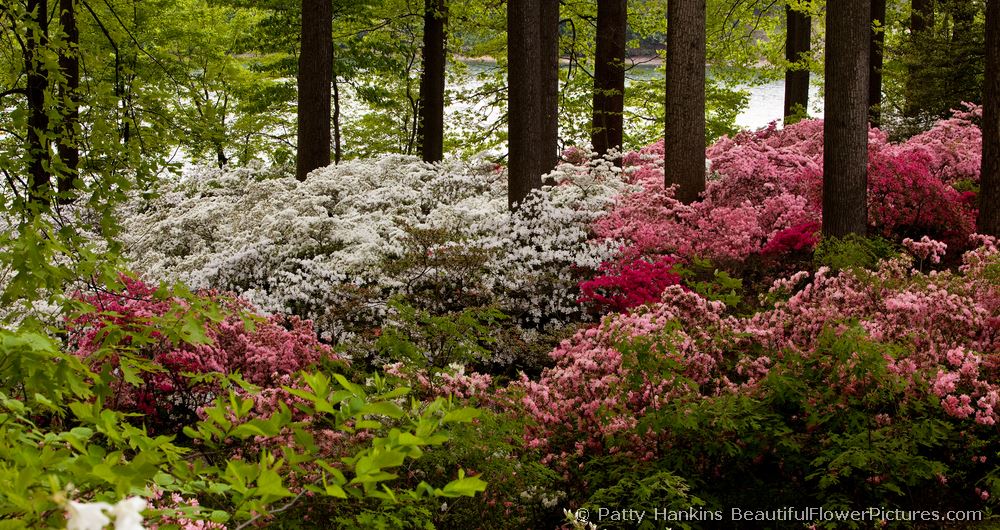
Azaleas in the Wood ©2009 Patty Hankins
Sometime it’s a line
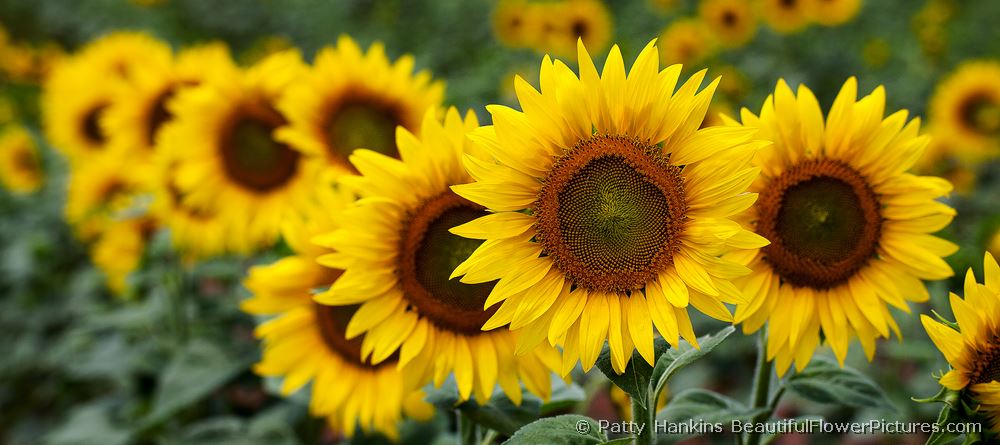
Sunflowers All in a Row © 2011 Patty Hankins
And sometimes it’s just something unexpected
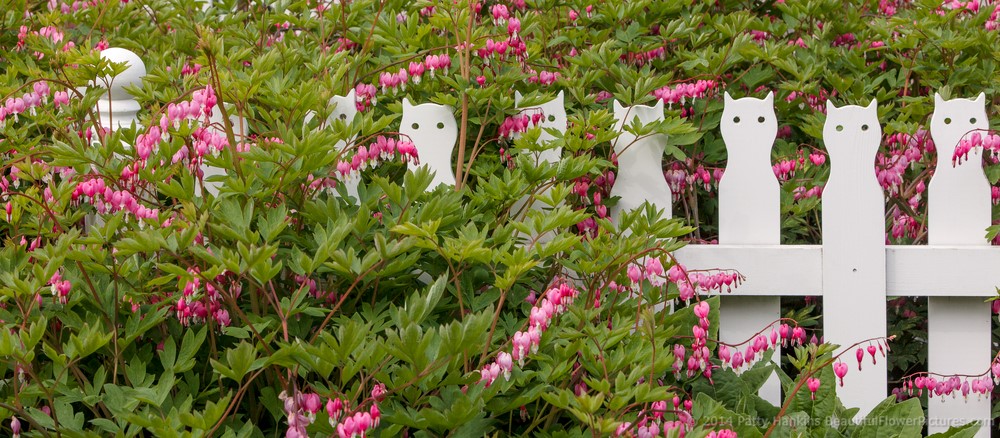
Along the Fence © 2014 Patty Hankins
So when you’re out photographing – be sure to take a moment to think about what caught your eye. It will help you create the photos you want to create.
Identifying what caught your eye and deciding how to capture that in your photo is one of the things we talk about in my workshops – including in my July 15-17 Photographing Flowers (Without Swearing at Your Camera) workshop. I’d love to have you join me for the workshop. You can find all the information about the workshop on my website.

by hankinslawrenceimages | Jun 3, 2016 | Photo Tips
When I’m out photographing I’m always surprised when people ask me why I still use a tripod. After all, in the digital age, we have image stabilized lenses and cameras that can shoot at very high ISO’s – so some people think we don’t still need to use a tripod.
At least in my case, I find that using a tripod makes me a better photographer.
One of the things I really like about using a tripod is that it allows me to slow down and think about the image I want to create. I find that when I’m hand holding my camera, I tend to just start shooting right away. When I’m using my tripod, I have to take a few moments to set up my camera and tripod – expand out the legs, get it to the right height, get it in the right position, and attach my camera to my tripod. While I’m doing that, I’m also looking at the scene and deciding how I want my photograph to look. I take more time composing my photo and deciding on the correct exposure and focal point. I end up taking better photographs because I spent time thinking about my photograph while setting up my tripod.
Another reason I use a tripod is that it holds my camera rock steady. When I’m photographing flowers with my macro lens, the slightest movement will often show up in my photographs. If I’m handholding my camera, just breathing and pushing the shutter release will move my camera a tiny bit. And that little bit of movement can dramatically affect how my photos look. When I use my tripod my camera stays exactly where I want to be. If I use a shutter release or wireless remote, I don’t have to touch my camera to take a photo – so I don’t add any motion to my image.

That’s All Folks Iris © 2016 Patty Hankins
A third reason I use a tripod is that it lets me focus my camera manually. I’ll admit it – my eyesight is not good enough for me to focus through the camera’s viewfinder. For me to accurately focus, I need to use Live View on the LCD screen. If I’m photographing flowers and handholding my camera, I can’t hold it steady enough to focus manually. I have to use Auto-Focus. On a tripod, once I switch on Live View, I can manually focus my camera and choose exactly the part of the flower will be the focal point of the image.

Babe Spray Roses © 2016 Patty Hankins
Another reason I use a tripod is that it lets me use longer exposure time. When I’m photographing flowers I usually want a reasonably fast shutter speed – just so I don’t have to worry about the flower moving in the wind. However, I often want a longer shutter speed when I’m photographing landscapes – especially if I’m photographing a sunrise or moving water. I used a shutter speed of 20 seconds for this photo of Middle Prong of Little River in the Great Smoky Mountains National Park.. I don’t know about you, but I can’t hold a camera steady for that long without a tripod.

Middle Prong Little River, Great Smoky Mountains National Park © 2015 Patty Hankins
The final reason I like using a tripod is that it makes it easier to check my image and if it’s not right, make adjustments as necessary. Once I take a photo, I like to review it on the back of my camera to see if I captured what I wanted to. If I didn’t, then I need to figure out what changes I need to make to capture the image I wanted to. If my camera is on a tripod, I know exactly where my camera was for the previous image, so can make adjustments based on that information. If I’ve been handholding my camera, I have to make my best guess as to where I was holding my camera for the previous image, and make adjustments based on a guess. I’ve found I’m much more successful making changes and getting the image I want when I use my tripod than when I’m handholding my camera.
So, that’s why I continue to use a tripod whenever possible.
Using a tripod is one of the skills I work with my students on in my workshops. My next workshop is my July 15-17 Photographing Flowers (Without Swearing at Your Camera) Workshop. Since we do lots of flower photography during the workshop, it’s a great chance to learn to use a tripod, or to become more comfortable using a tripod. I’d love to have you join me for the workshop. More information (including registration info) is on my website at http://beautifulflowerpictures.com/photographing-flowers-without-swearing/
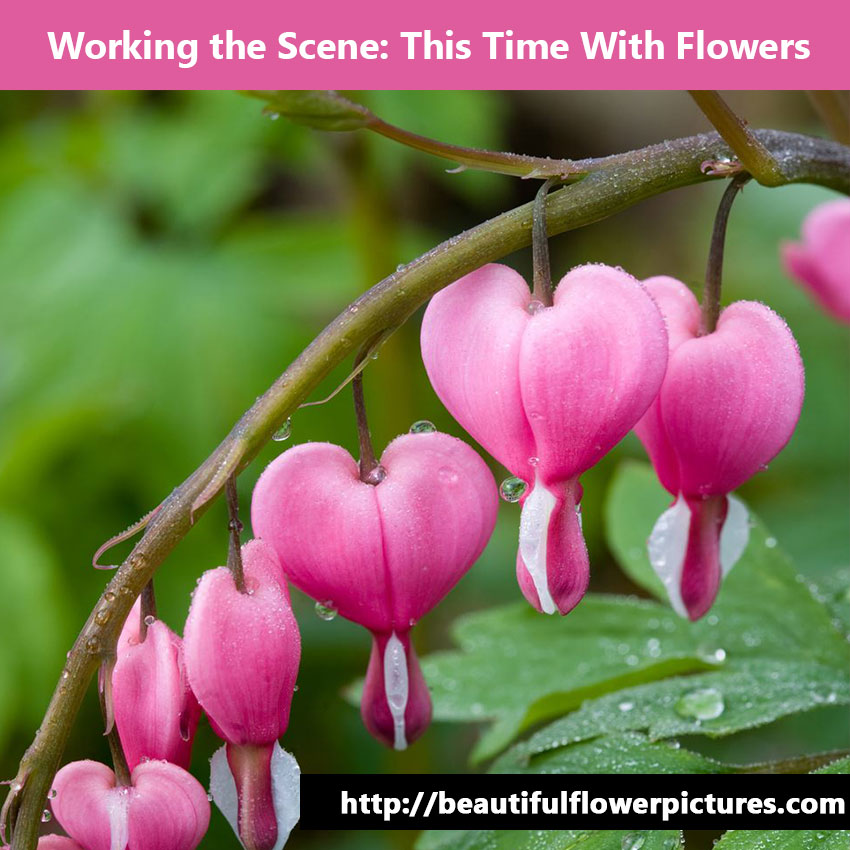
by hankinslawrenceimages | May 13, 2016 | Photo Tips
A few months ago I shared an article about Working the Scene where I talked about trying different compositions when you’re in the field photographing the landscape. Since then, I’ve gotten a few questions asking if I do the same thing when photographing flowers. And the answer is yes.
I do the same three things photographing a flower at a garden as I do when I’m photographing a landscape.
- Try different focal lengths. If you’re looking through a telephoto lens, you will get very different compositions then when you are using a wide angle lens. I often start with a wide angle lens, and then pull out my macro lens. Sometimes I’ll even pull out a longer telephoto lens if that’s what I need to get the photo I want.
- Try portrait and landscape compositions. The change from horizontal to vertical orientation of your camera will force you to include and exclude different parts of the scene, and will help you to think about the scene in different ways.
- Move around and try again. When I first see a flower or group of flowers I want to photograph, I usually see what I think is the perfect image in my mind. So I’ll set up my tripod and grab the lens I need, and create that photo. Then I’ll take a moment and review the image on the back of my camera to see if it’s what I want and more importantly, is it the best image I can create. If not, I’ll take another look at my subject and see if there is composition I like better, move my tripod, reassess my lens choice and take that photo. Re-evaluate and set up another shot if I still don’t have what I want. Most of the time I’ll create 4 or 5 very different compositions of a specific flower or group of flowers before deciding that I’ve what I’m looking for. Moving my tripod up or down, a few inches to the left or to the right can make all the difference in the world.
Here are some of my photos of a bleeding heart plant I took several years ago that illustrate how I work a scene with flowers
One photo I took was of the whole bleeding heart plant in front of a tree trunk and wall. Decided it was too busy and didn’t really show off the heart shaped flowers.
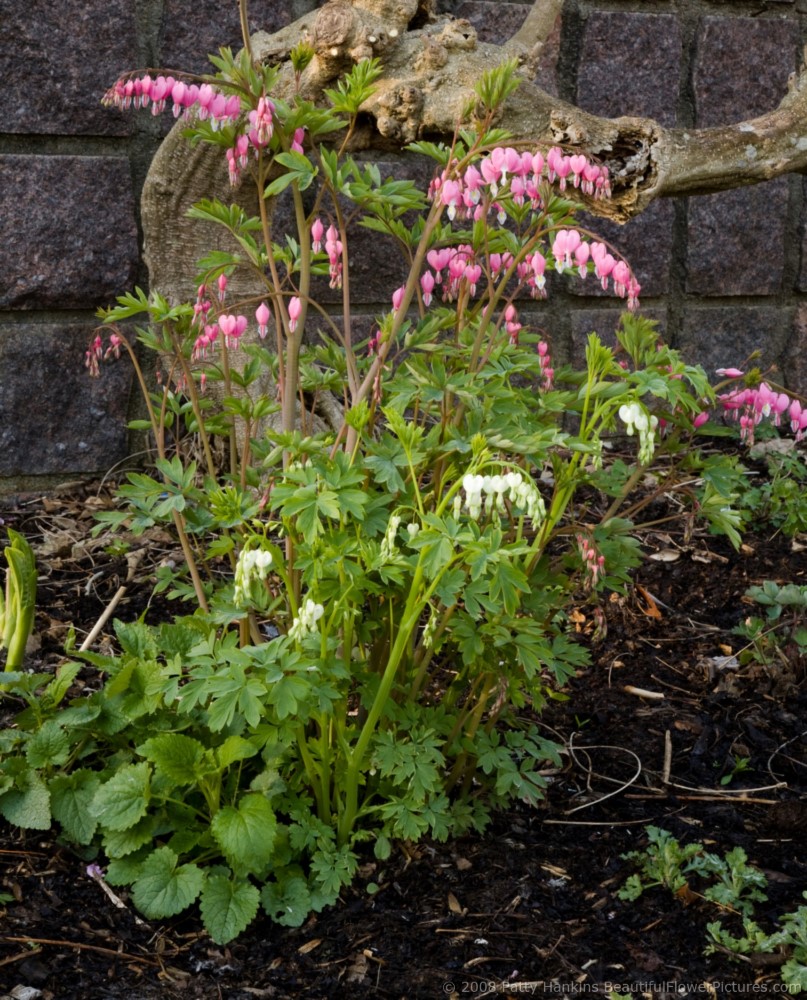
Bleeding Hearts © 2008 Patty Hankins
So I moved in closer to just included a few of the branches. I also changed my aperture so that the wall and tree trunk were no longer in sharp focus. Still not right.
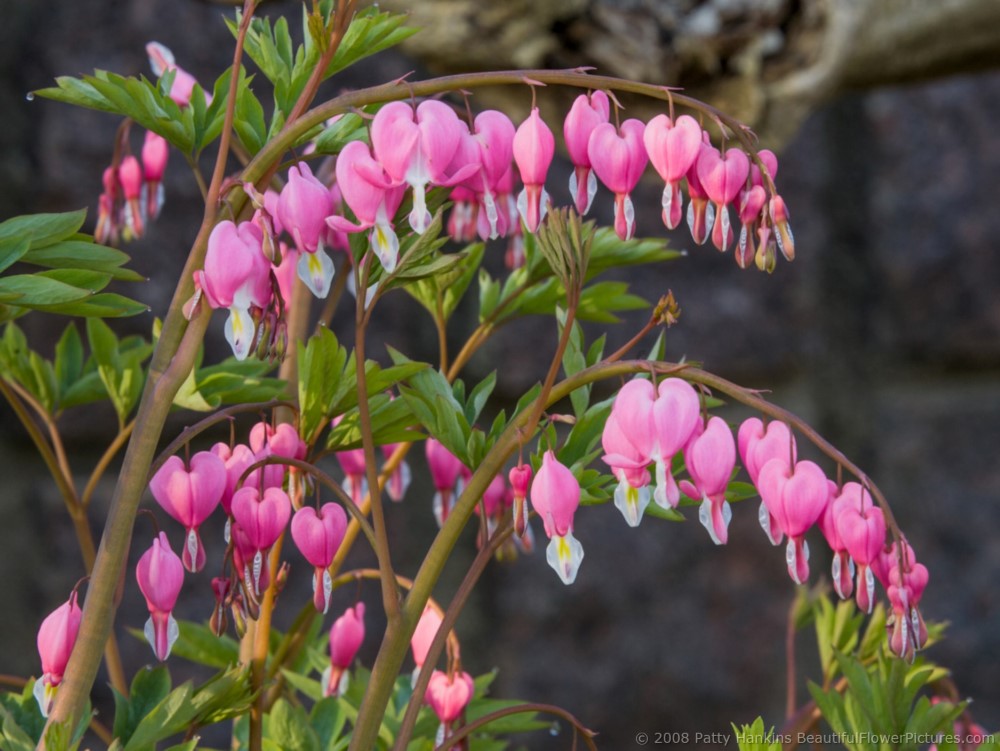
Bleeding Hearts © 2008 Patty Hankins
So next I moved my tripod around to another side of the plant, framed up just one branch of blossoms with a very shallow depth of field so only one flower was in sharp focus. Still not right.
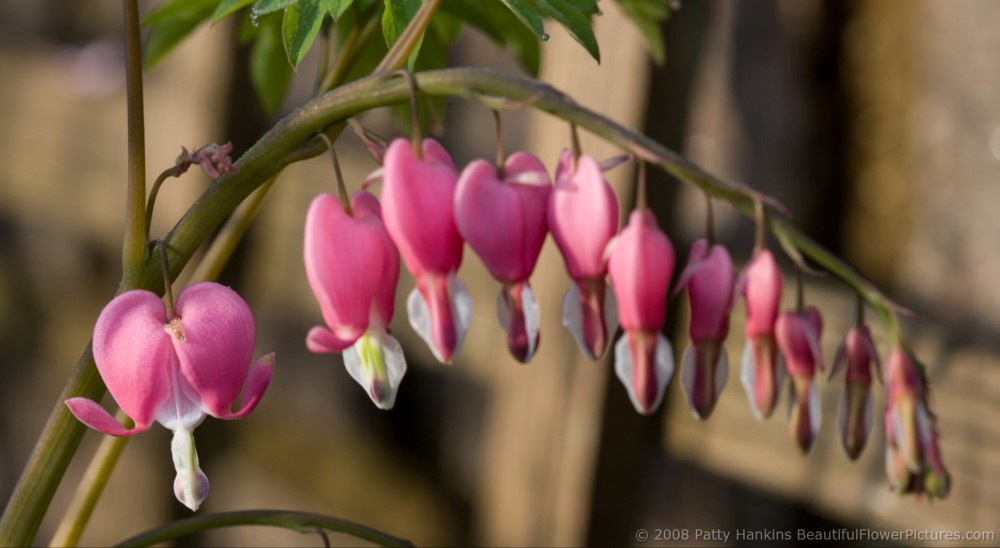
Bleeding Hearts © 2008 Patty Hankins
So I switched to portrait orientation and moved in closer so I only had a few flowers in my photo. I also switched to my macro lens. Just didn’t like the light wood background or that the flowers in the upper right were in front of the main subject and out of focus. Still not right.
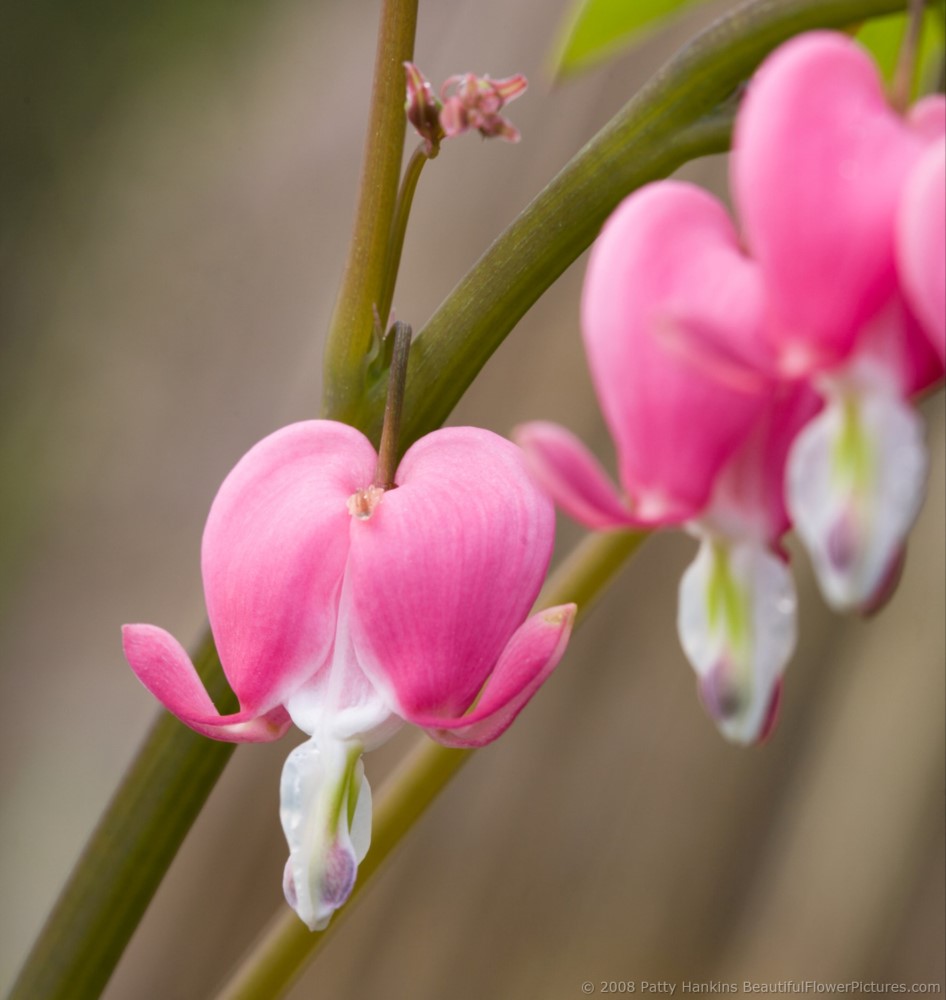
Bleeding Hearts © 2008 Patty Hankins
So I moved my tripod again so that the flowers were backed by green leaves instead of the brown wood and that I was further away from the bleeding hearts. This gave me the opportunity for a wider angle photo showing an entire branch of the flowers including the buds at the end. Better – but still not quite what I wanted.
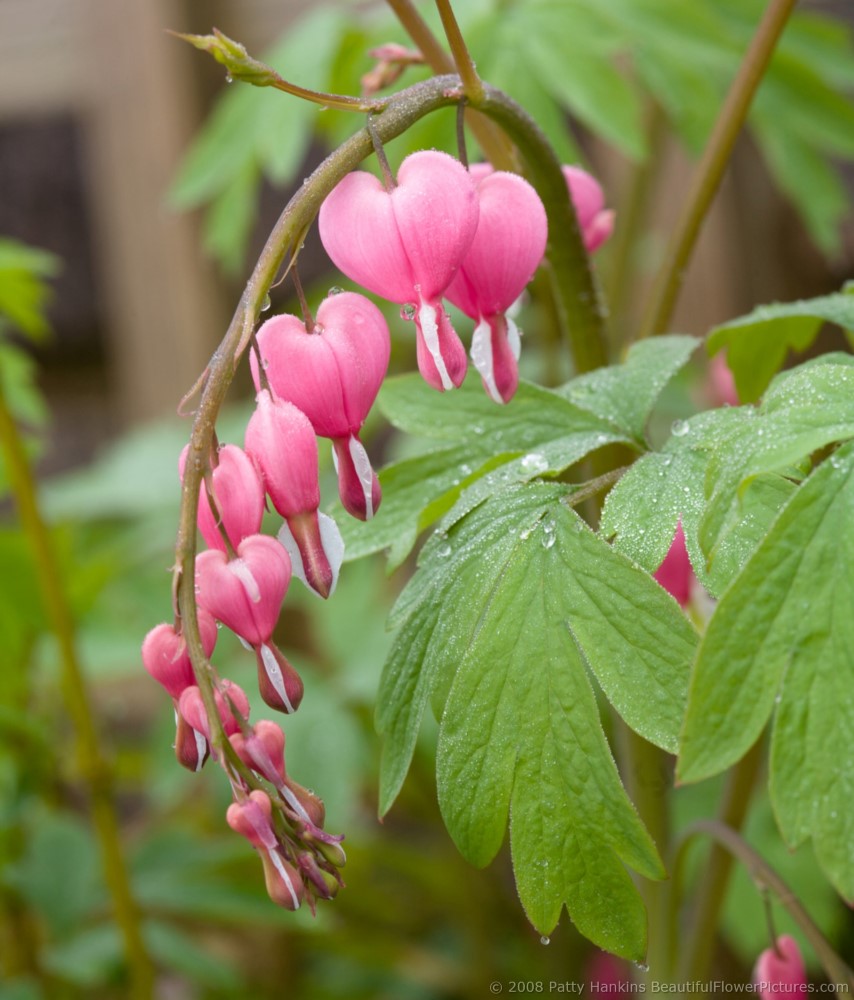
Bleeding Hearts © 2008 Patty Hankins
So I moved my tripod one more time – this time in a little closer and switched back to landscape orientation knowing I’d crop to a square for the final photo. I focused in on just a few of the heart shaped blossoms, made sure the water droplets were in sharp focus, and that the branch would act as a leading line to draw your eye through the photo. Finally I had my photo – and this has been one of my best selling photos over the years.
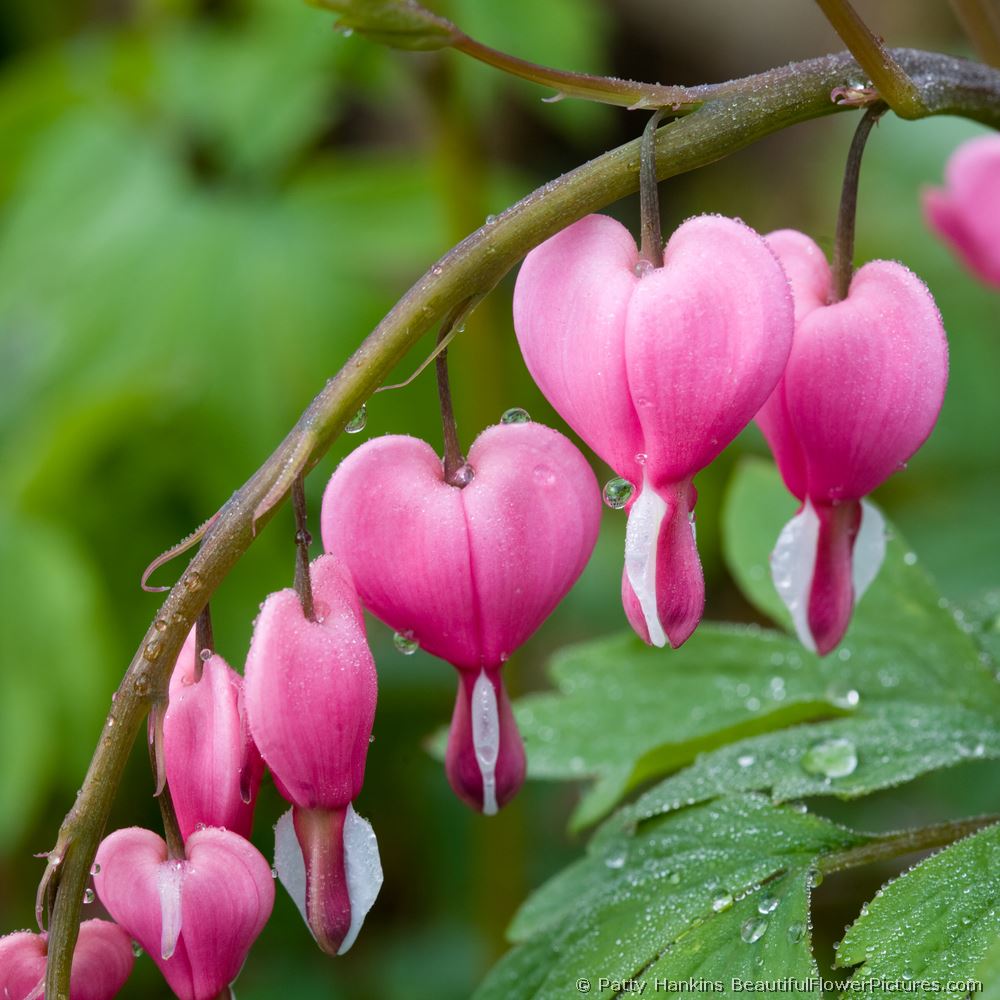
Bleeding Hearts © 2008 Patty Hankins
And if you are photographing at a botanical garden there’s one more photo you really should take when you are working the scene – a photo of the identification sign so you know what flower you’ve been photographing.
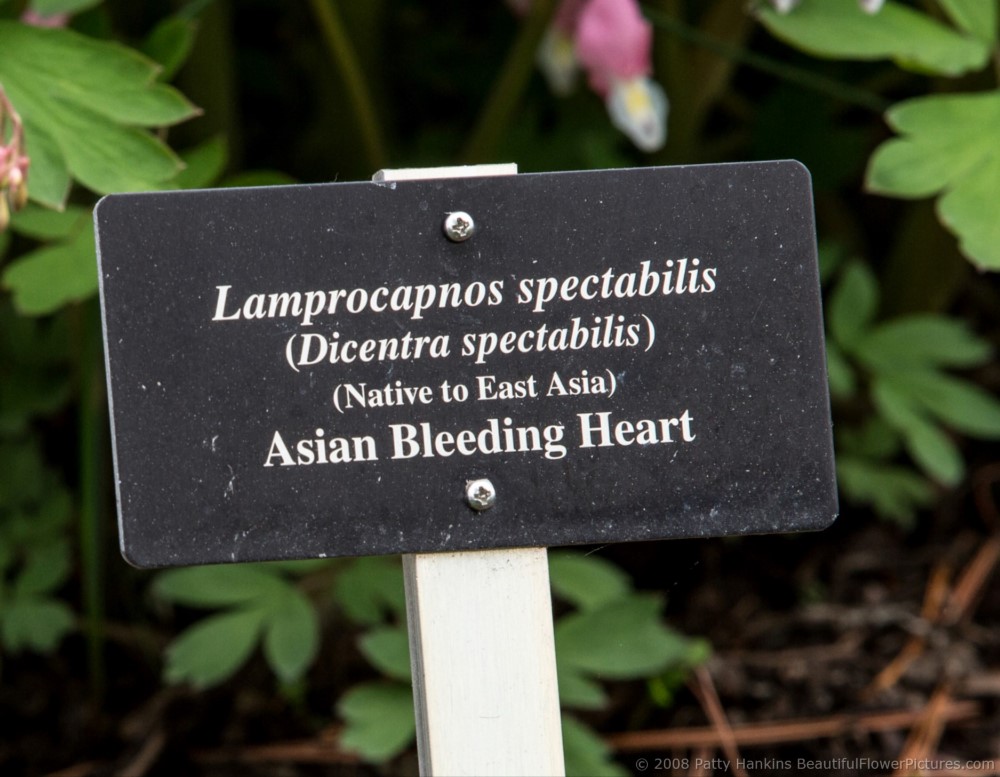
Bleeding Hearts © 2008 Patty Hankins
Working the scene is one of the ideas we’ll be talking about and practicing during my July 15-17 workshop – Photographing Flowers (Without Swearing at Your Camera). There are still a few spaces open in the workshop. I’d love to have you join me for a weekend of photographing flowers.
All the details about the workshop and registration information is at http://beautifulflowerpictures.com/photographing-flowers-without-swearing/.
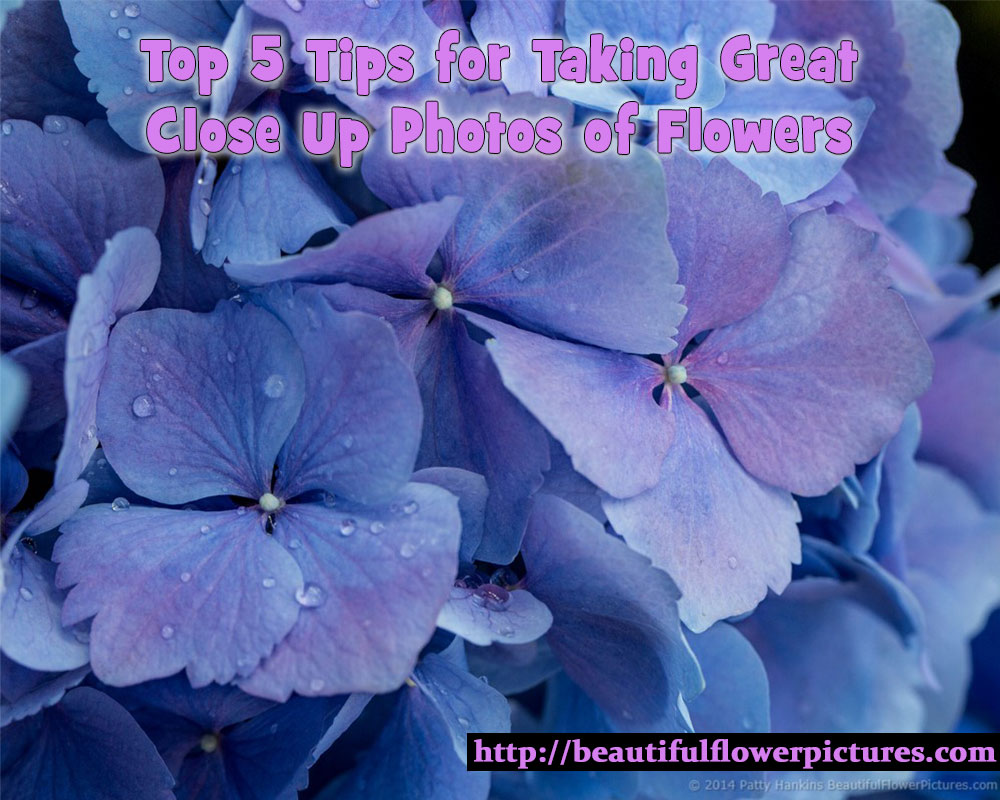
by hankinslawrenceimages | Apr 8, 2016 | Flowers, Photo Tips
Spring is in full bloom here in the Washington DC area – even if we are having a bit of a cold spell this week. I can still see a few cherry blossoms on the tree in my front yard, the Virginia Bluebells are blooming at local parks and tulips are blooming at local gardens. As I’m photographing flowers on almost a daily basis, I’m noticing that I’m taking many more close up photos of flowers than I have in the past – especially when I’m in my studio. Many of the photos show only part of a flower — not even a whole blossom. The close up photos have gotten a great response from people who have seen them — and lots of questions about how I take them. So I thought I’d share a few tips on taking great close up photos of flower with you today.
1. Think about What Caught Your Eye: Before you click the shutter, think about what it is about the flower that caught your eye and made you want to photograph it. Was it the color, the shape, the dewdrops or the way light is striking the flower? Now compose your photos to highlight what caught your eye.
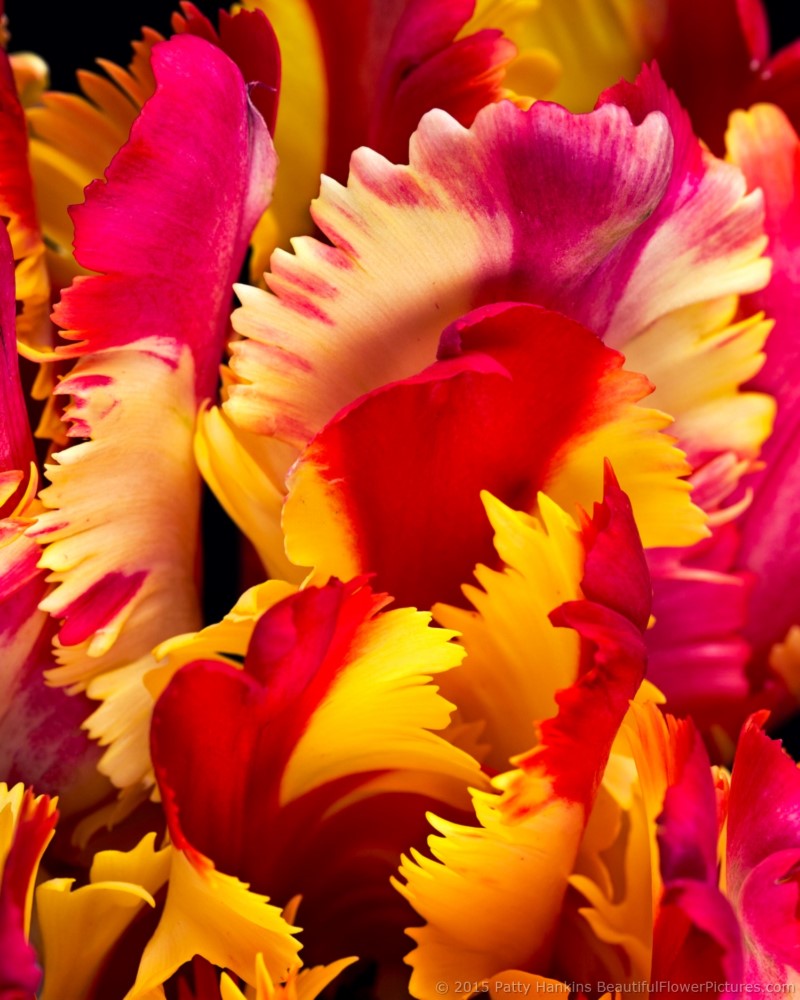
Petals of a Flaming Parrot Tulip © 2015 Patty Hankins
2. Use a Macro Lens (or Macro Setting on Your Camera) For close up photos you want to be able to get as close to your subject as possible. Macro lenses or the Macro Setting on your camera (often symbolized by a little flower) allow you to get much closer to a subject and still have it in focus than using either a non-macro lens or setting
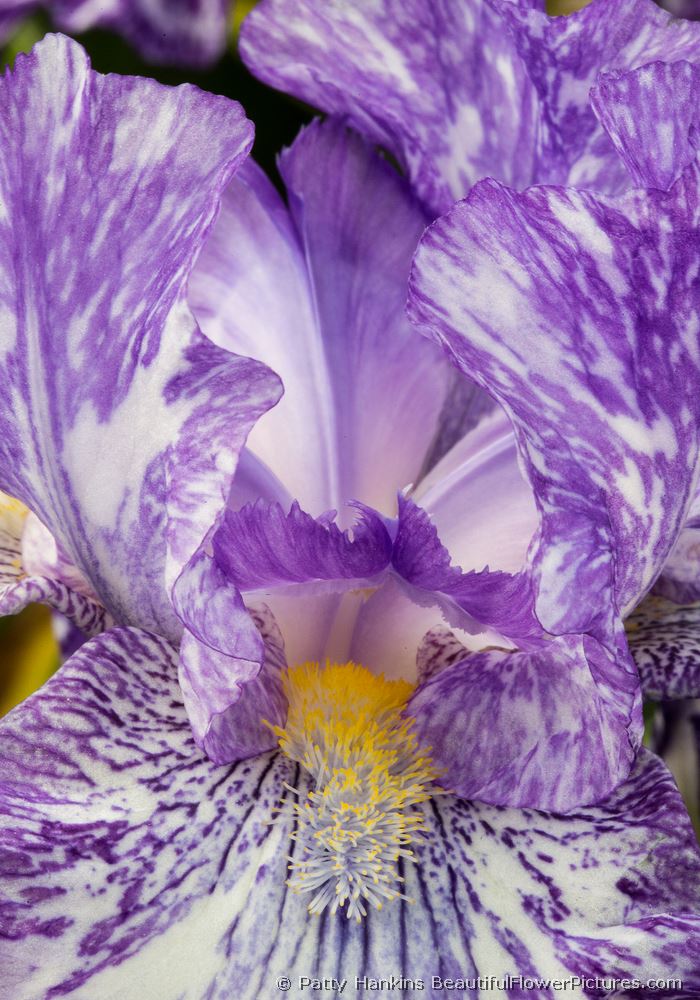
Purple Streaker Iris © 2013 Patty Hankins
3. Use a Tripod.I know — we live in an age of image stabilization/vibration reduction cameras and lenses, to say nothing of high ISO cameras so we can get faster shutter speeds — so a lot of the time we can get away with not using a tripod. But when it comes to close up photos I really recommend using one. When you are focused in on a very small area, the slightest motion of the camera (including that caused by clicking the shutter button) can introduce motion blur and lack of clarity in your focus. So if you want to take really crisp clear close up photos — use a tripod
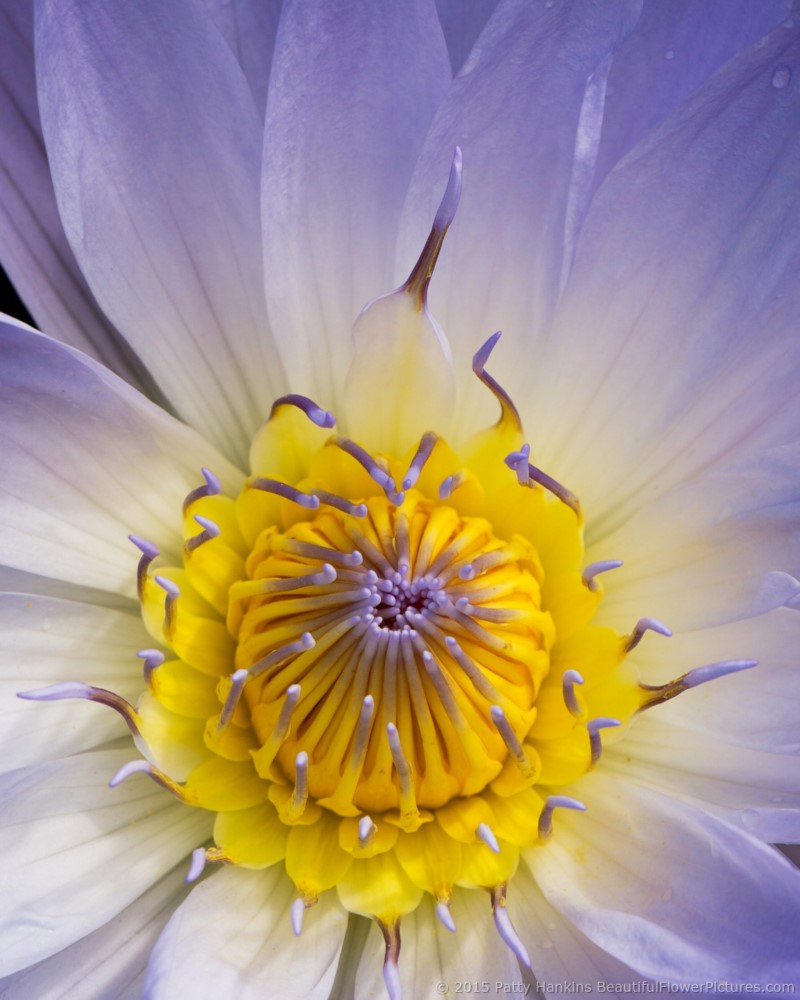
Bob Trickett Water Lily © 2015 Patty Hankins
4. Try Different CompositionsDon’t photograph the flower from just one angle. Move around and see what else you see. Try taking photos of the center of the flower, or the petals, or just one specific detail. If you’re photographing with a digital camera there is basicly no additional cost to taking more than one photo of a scene. So go ahead — try different compositions. Who knows — you may discover you like the petals of the flower better than the center!
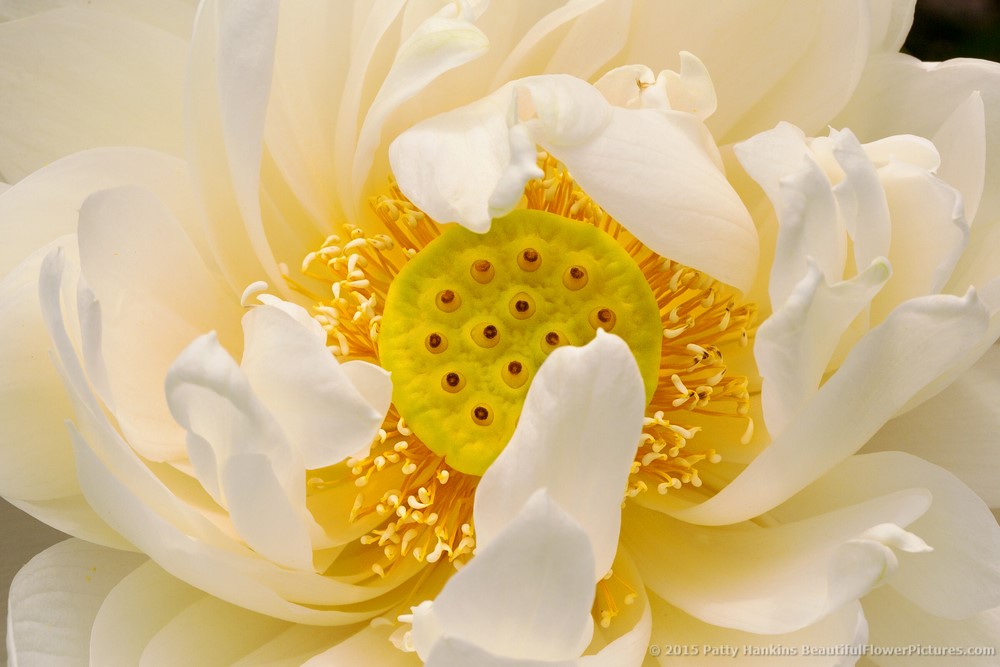
White Lotus © 2015 Patty Hankins
5. Try Different AperturesIf you are photographing in Aperture priority, try changing the aperture (f-stop) you’re using and see what this does to your photo. You may be surprised to find that sometimes a narrow depth of field gives you the look you want — and at other times, a larger depth of field is perfect for what you’re trying to show in the photo
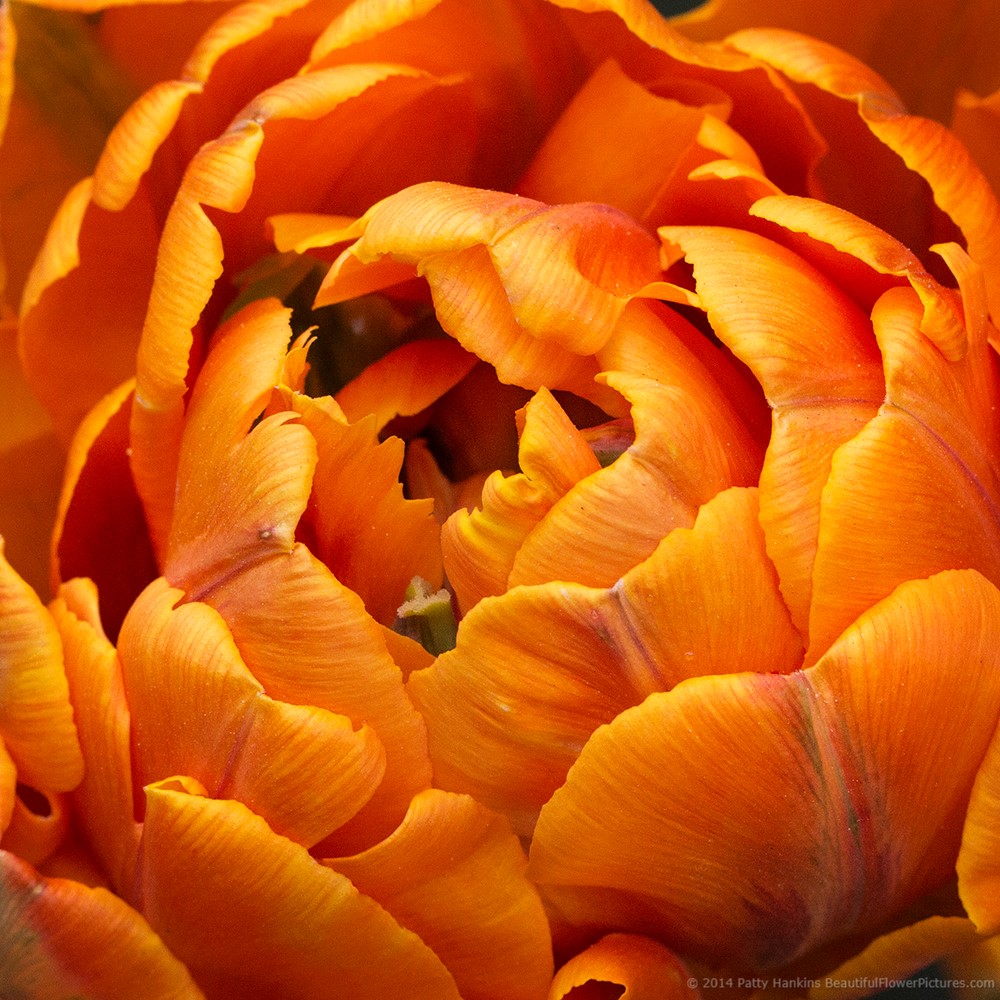
Orange Princess Tulip © 2014 Patty Hankins
Bonus Tip: Have Fun! Have fun while you’re photographing. Don’t forget to slow down and take few moments to appreciate the beauty of nature around you.
If you found these tips helpful – consider joining me for my Photographing Flowers Without Swearing at Your Camera workshop on July 15-17. During the workshop we’ll talk about how to take better flower photos – and visit a few of my favorite gardens so we can take some wonderful photos of flowers
More info about the workshop is at http://beautifulflowerpictures.com/photographing-flowers-without-swearing/
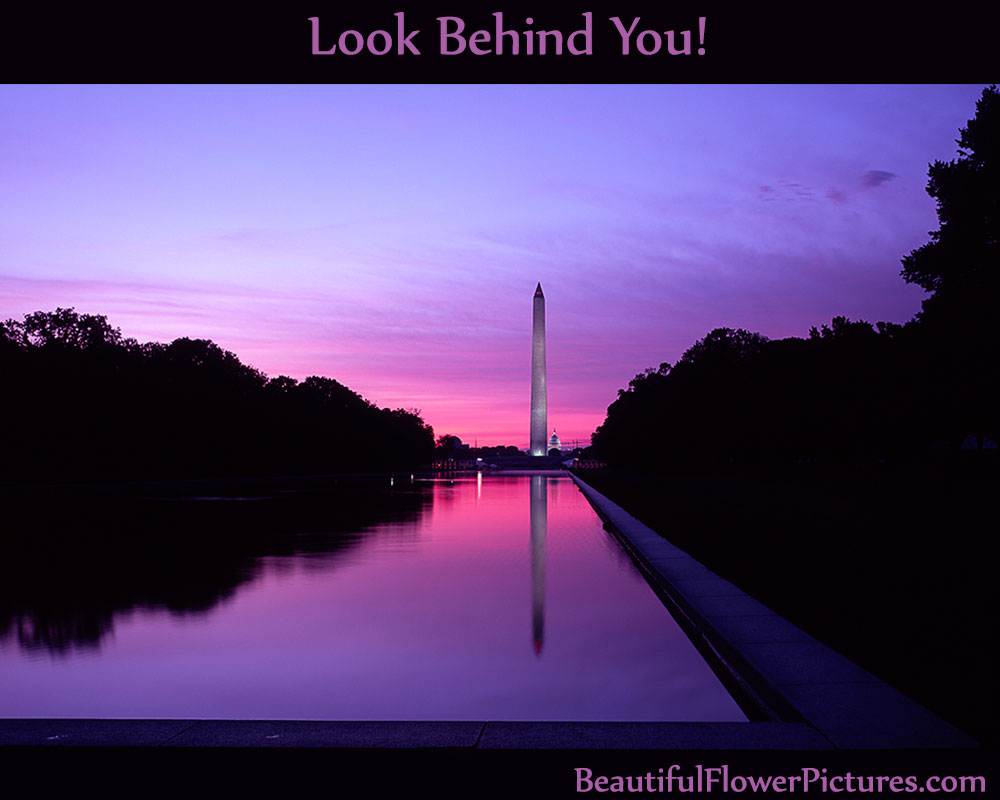
by hankinslawrenceimages | Feb 12, 2016 | Photo Tips
Bill and I are just back from teaching our landscape photography workshop at the Chincoteague National Wildlife Refuge in Virginia. I’m hoping to share some of the photos I took over the weekend with you next week. This week, I thought I’d share an article we published last year about always looking behind you when you are out photographing. There are several spots in the Chincoteague National Wildlife Refuge where there are wonderful photographic opportunities both in front and behind you when you stand in some of the classic scenic spots. – Patty
One aspect of working the scene that Bill and I encourage our students to think about is to always be aware of your environment. As a landscape or nature photographer, you are photographing in a three dimensional world with 360 degrees of space around you.
So often we’ve seen photographers so intent on capturing the scene in front of them that they totally miss other nearby photo opportunities – including ones directly behind them.
Over the years, Bill and I have taken pairs of wonderful photos where the second was taken 180 degrees in the opposite direction from the scene we had planned on photographing.
Several years ago, Bill was photographing inside the Lincoln Memorial in Washington, DC in hopes of photographing the full statue of Abraham Lincoln without any people in the photo. He happened to turn around to see one of the most amazing sunrises we’ve ever photographed.
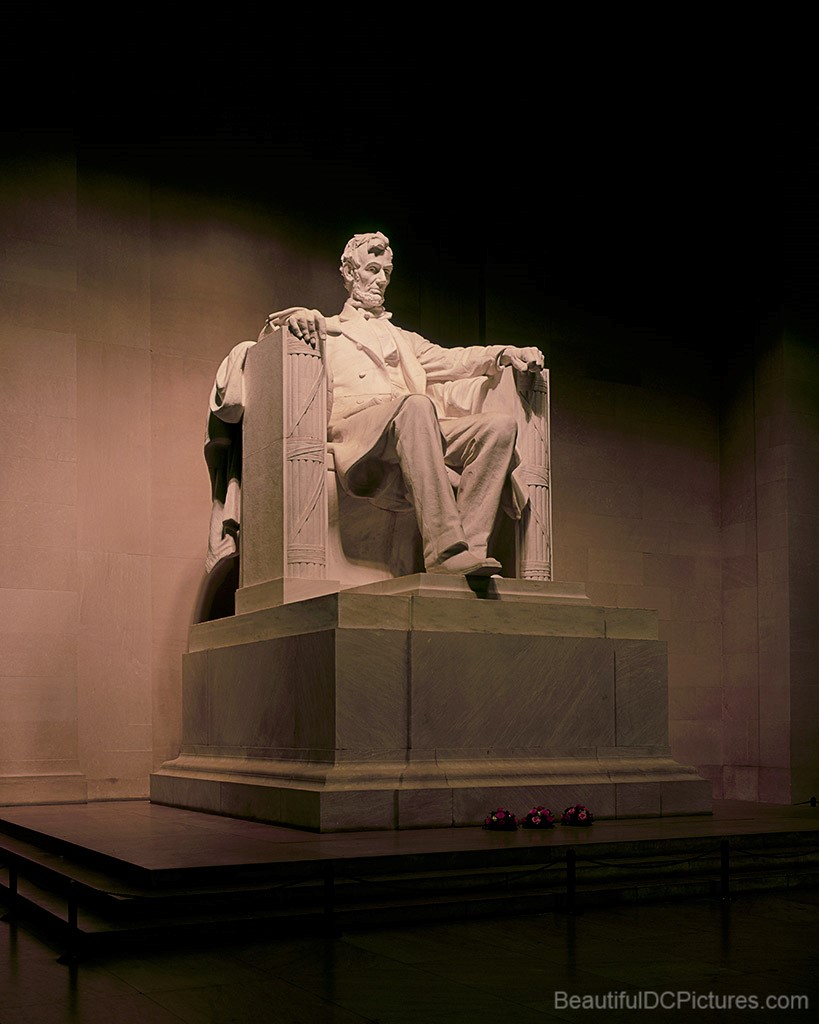
Lincoln Memorial © 2004 William Lawrence
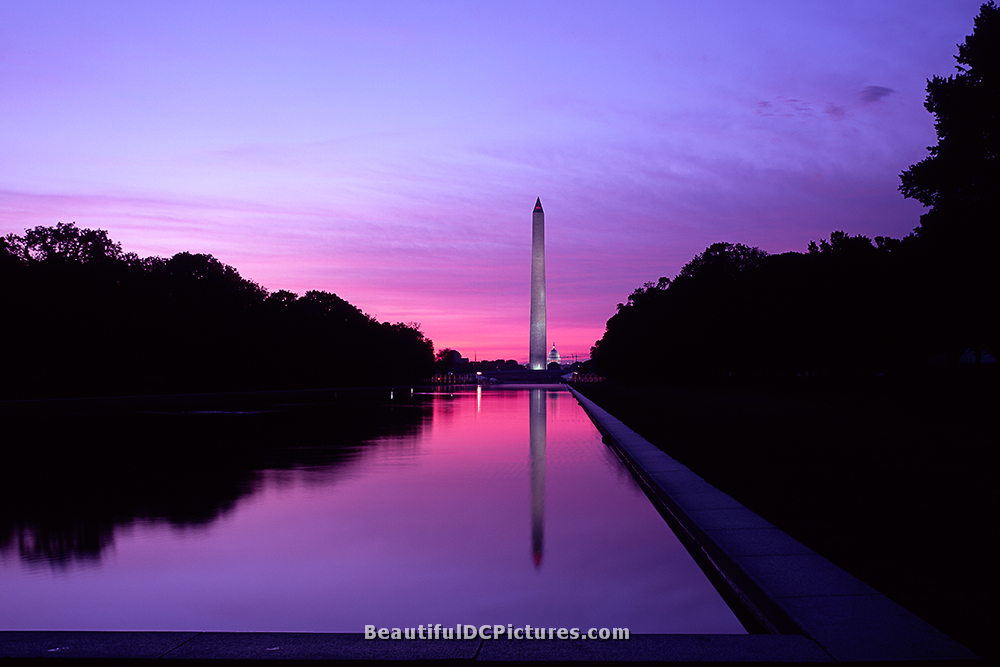
DC Sunrise © 2004 William Lawrence
When we’re on a photo trip, Bill and I frequently spend the middle of the day scouting locations for future photo sessions. The light isn’t as good mid-day as it is early or late in the day – and it gives us a chance to plan our upcoming shoots. We try to find places where we can not only photograph the sunrise before the sun comes up, but also where we can photograph the wonderful golden light that occurs 180 degrees away from the sun shortly after the sun comes up (or shortly before the sun goes down). Some of our favorite spots are places where we can literally turn around and photograph something wonderful after the sun comes up over the horizon.
One of these spots is in Chincoteague National Wildlife Refuge in Virginia. We frequently photograph one section of the marsh before the sun is up – and then turn around and photograph another section just after the sun rises.
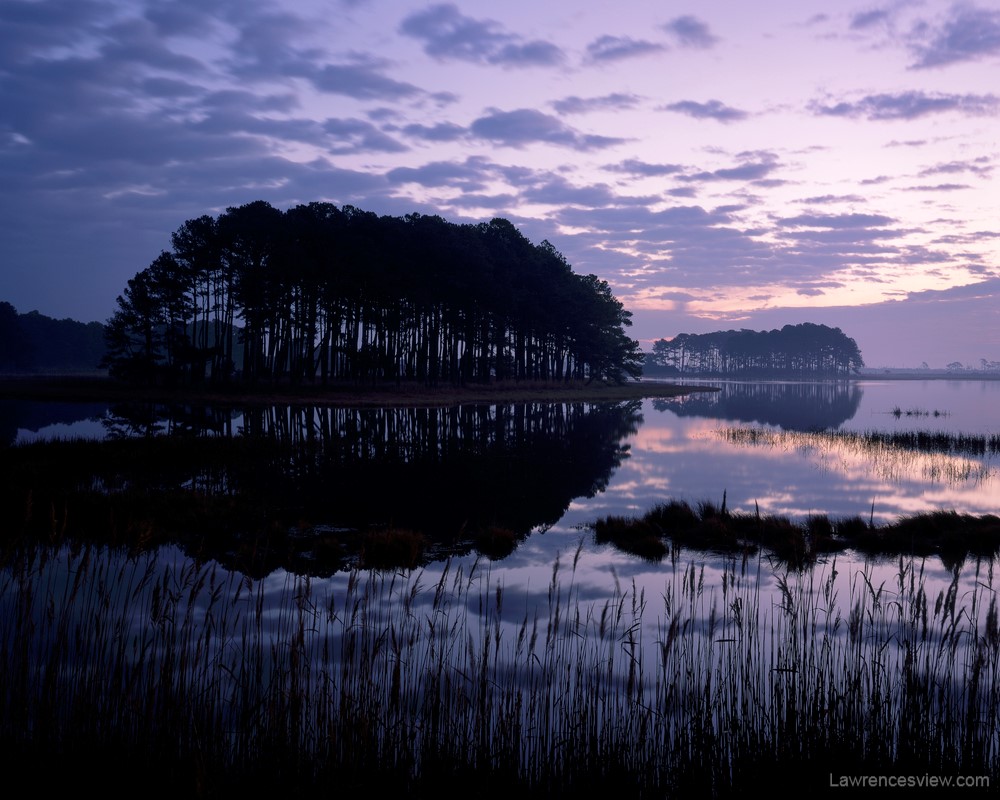
Chincoteague Sunrise © 2006 William Lawrence
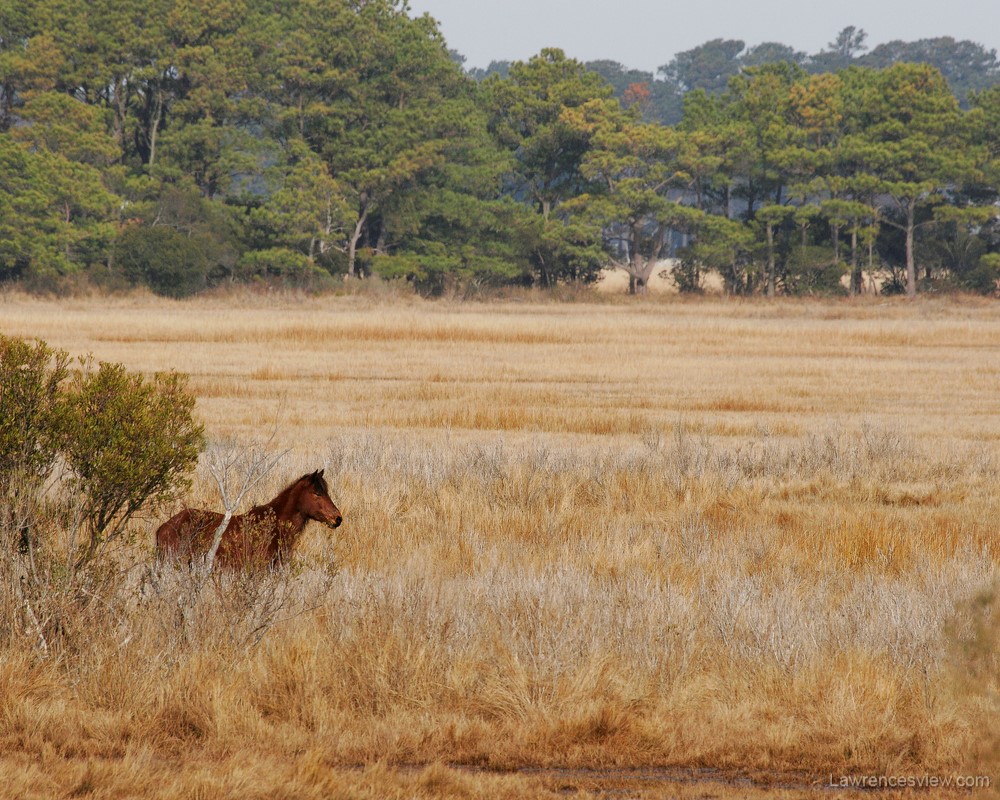
Chincoteague Pony © 2006 William Lawrence
At Bosque del Apache National Wildlife Refuge in New Mexico we photographed a spectacular sunrise over the frozen pond. In one direction the sky was filled with intense shades of yellow and orange. In the opposite direction it was filled with soft shades of blue and pink.
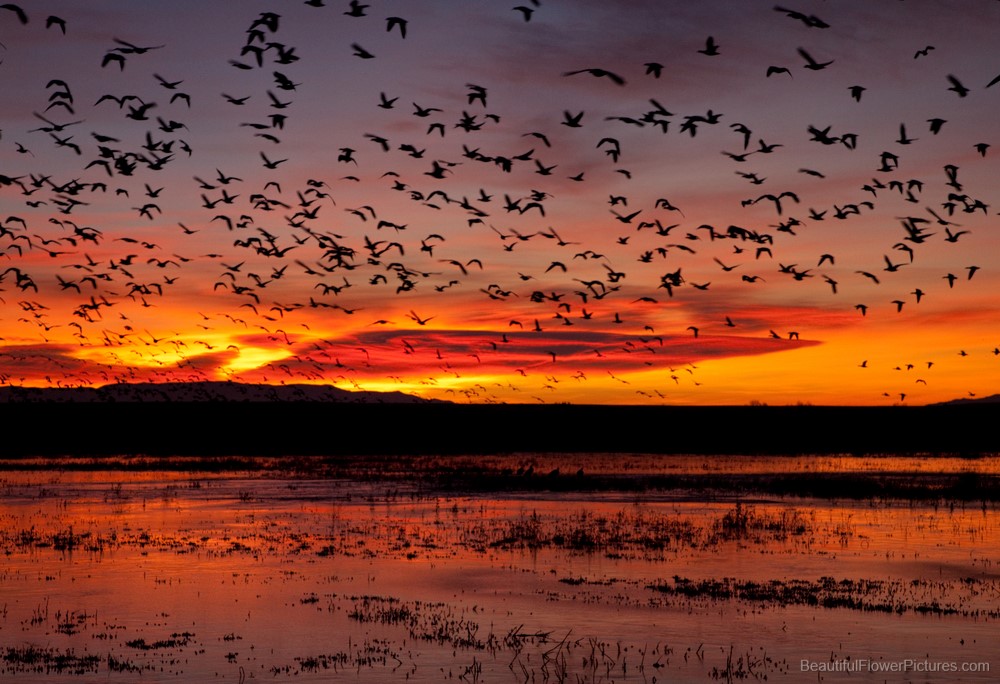
Sunrise at Bosque del Apache ©2009 Patty Hankins
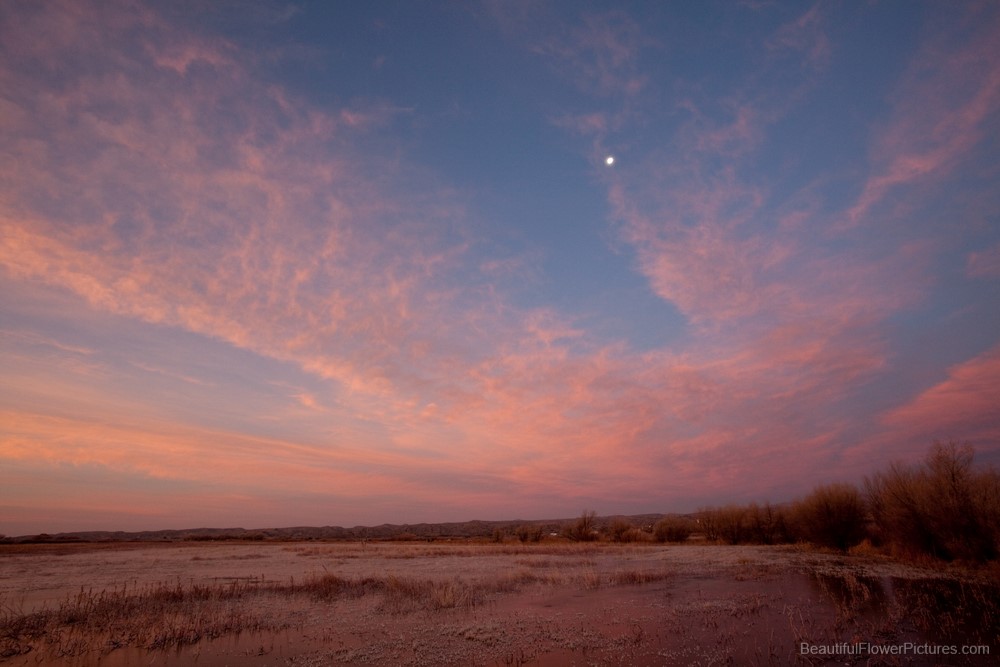
Sunrise at Bosque del Apache ©2009 Patty Hankins
The other reason to always be aware of your surroundings when photographing is you never know what might be coming up behind you. It could be a bear, a speeding car, or someone who’s not paying attention to what’s in front of them and is about to walk into you and your tripod.
Or it could just be a curious turkey vulture checking out your camera gear the way this one did while Bill was photographing a butterfly in the Big Cypress National Preserve in Florida.
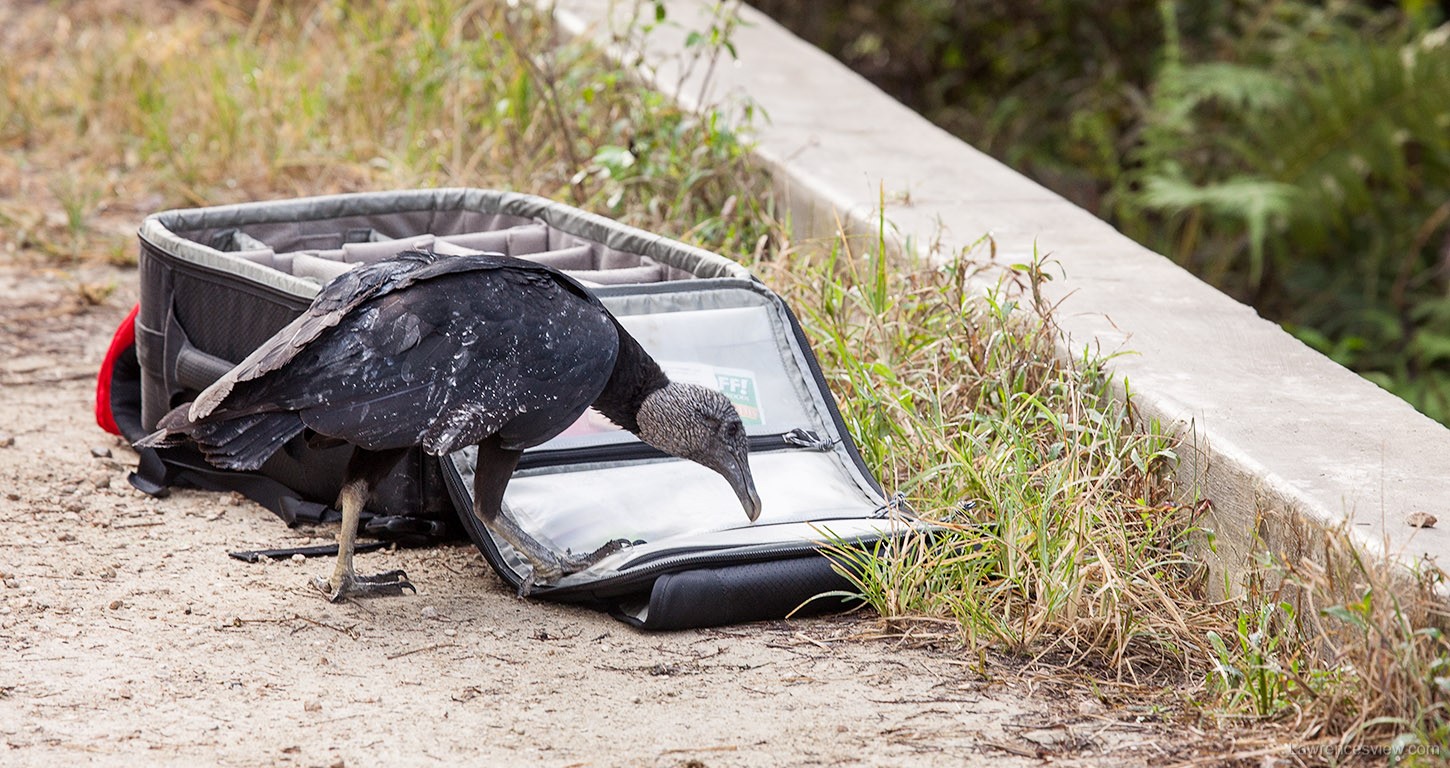
Turkey Vulture © 2013 William Lawrence
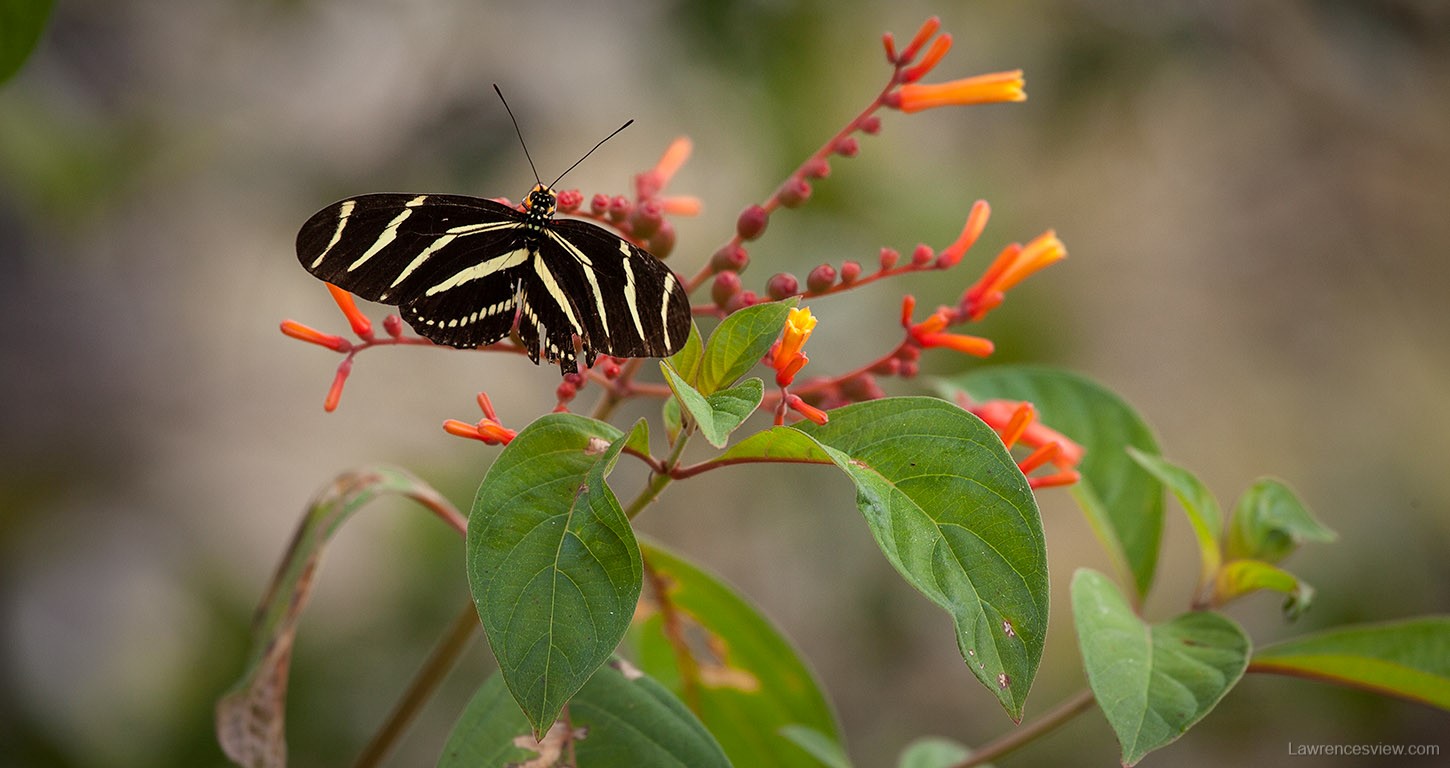
Butterfly © 2013 William Lawrence
Remembering to look behind you is just one of the landscape photography ideas we talk about in our workshops. If you’re interested in learning more, please join us for one of our workshops. You can find all of our upcoming workshops at http://beautifulflowerpictures.com/2016-workshops/
We’d love to have you join us for one of our workshops.
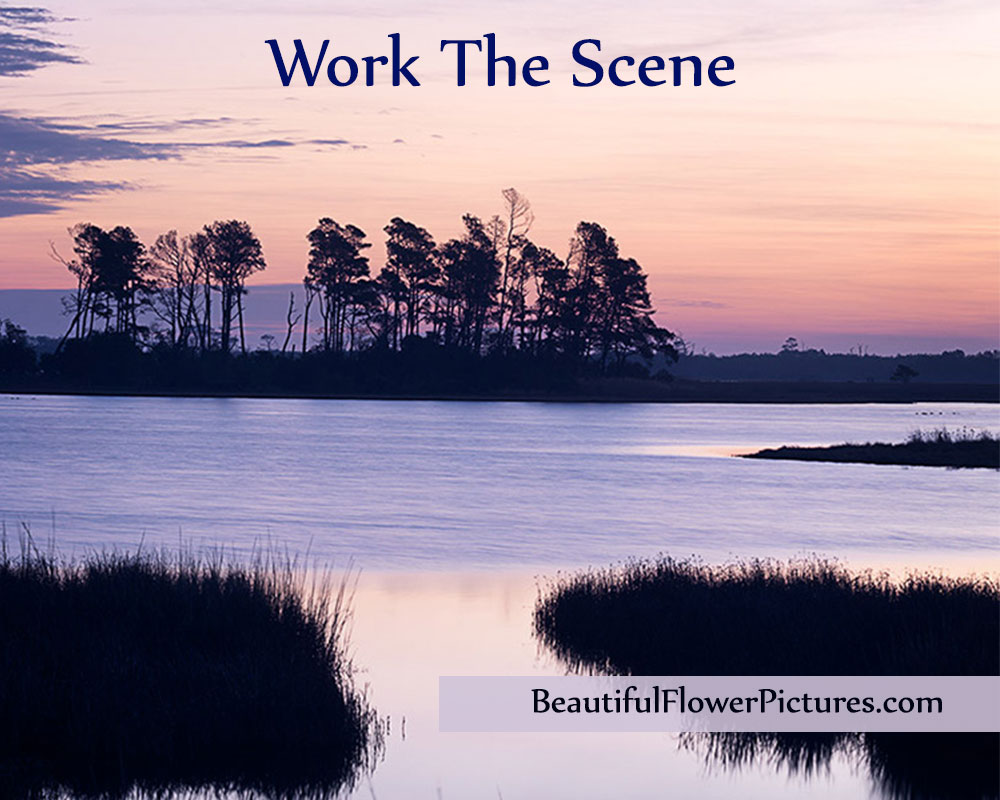
by hankinslawrenceimages | Jan 15, 2016 | Photo Tips, Virginia
Have you ever stopped to photograph a great scene, and then when you get home realize that you would have had the perfect shot, if only you had gone wider, gotten in closer, been 3 feet to the left, etc? One of Bill’s and my major recommendations to our students is that when you see that scene that catches your eye, and you decide you must photograph it, is that you work the scene.
What does this mean? When we approach a scene, often a shot will come to mind, and we set up and take that particular photograph. But once that is out of your system, stop and take a look at the scene with an eye towards what other shots you can compose. How do you do this? The first thing is to take a moment and look, with an eye towards what different compositions you can see. You can try several things that will help you think of different photos:
- Try different focal lengths. If you’re looking through a telephoto lens, you will get very different compositions then when you are using a wide angle lens. We often start with a wide angle lens, then use a telephoto to pick out some of the more interesting details in the scene.
- Try portrait and landscape compositions. The change from horizontal to vertical orientation of your camera will force you to include and exclude different parts of the scene, and will help you to think about the scene in different ways.
- Move around and try again. Typically, when we are happy with a shoot in one spot, we’ll pick up the tripod (you are using a tripod, aren’t you?) and walk around to look at the scene from different angles. This keeps you from being stuck in one set of “tripod holes” never moving from one place. Walk ten feet/ a hundred feet/ a hundred yards (depending on your circumstances – you’d be amazed what a difference 10 feet can make in getting components of your scene to line up) and see if you like what you see. Set your tripod again and start seeing what shots look better from the new angle.
Please note that we regard working the scene as different from “machine gunning”, or indiscriminately keeping your camera shooting without giving thought to what you are shooting. You still need to think about your composition, but any scene has more than one good composition in it (we’ve learned this extremely well – put the two of us in the same place with the same gear, and you will get very different compositions).
Here are some of Bill’s photos from a sunrise in the marsh at Chincoteague National Wildlife Refuge.
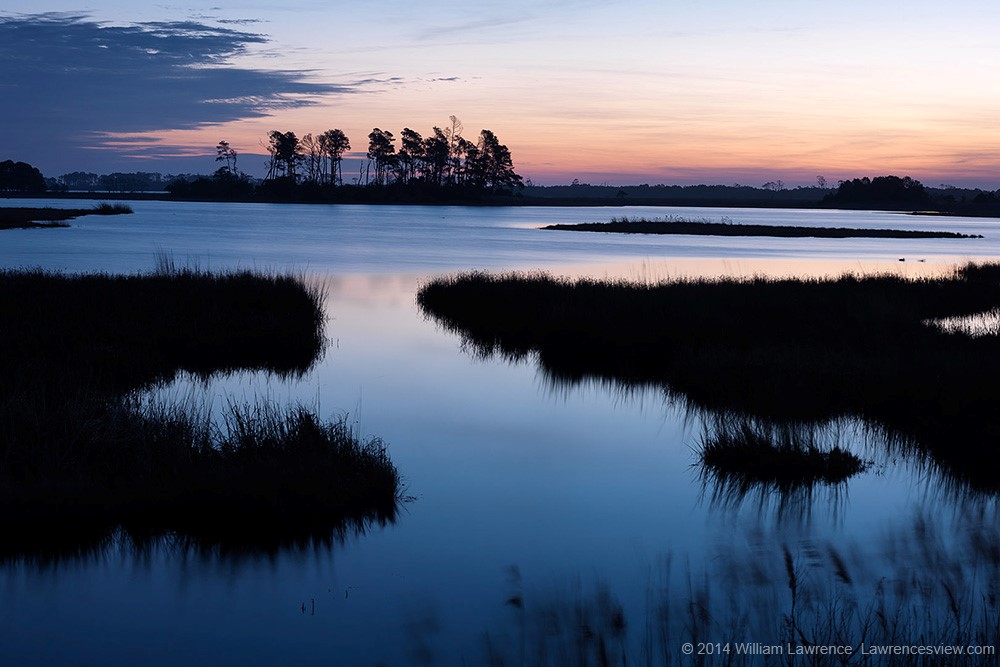
Sunrise at Chincoteague National Wildlife Refuge © 2014 William Lawrence
What attracted Bill’s attention to the original scene was the lovely light silhouetting the trees in the background, with the light reflected by the water in the foreground. In walking the scene before placing his tripod on the ground, he decided that the ideal place was where the channel of water in the foreground made a leading line into the scene (and you’ll see that he kept that concept throughout). Throughout the shoot, he moved both camera right and camera left to try different compositions (not much here – probably 10-15 feet, so that he didn’t lose the channel in the foreground). Bill shot several portrait compositions with a longer lens, and even tried to consider what might look good in black and white (so looking for form and tone as opposed to color).
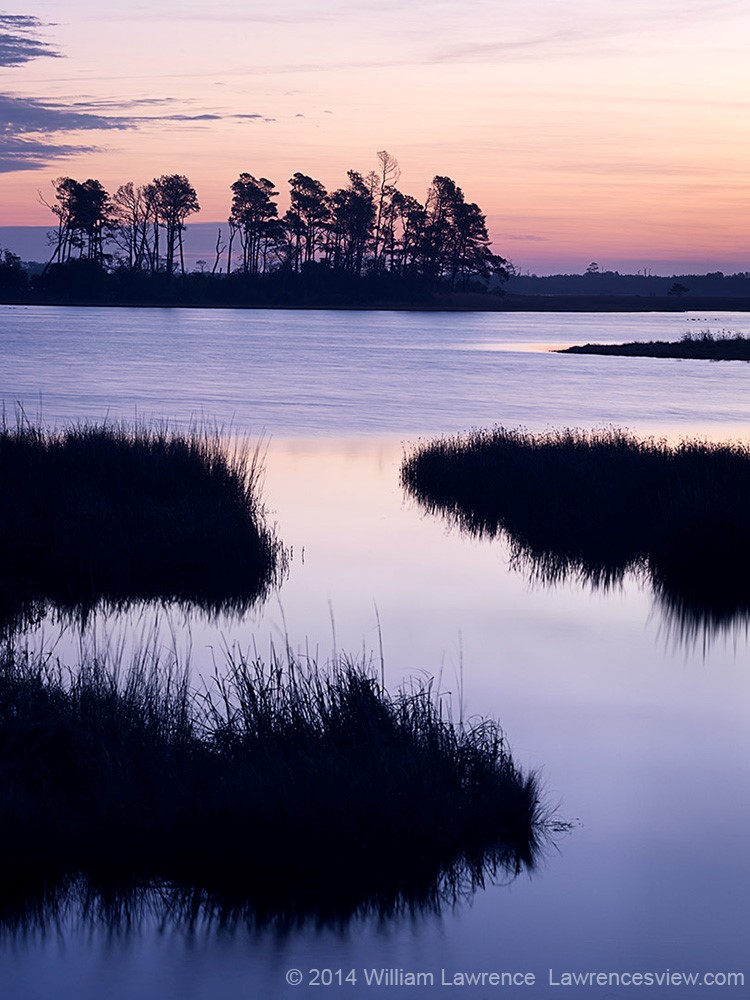
Sunrise at Chincoteague National Wildlife Refuge © 2014 William Lawrence
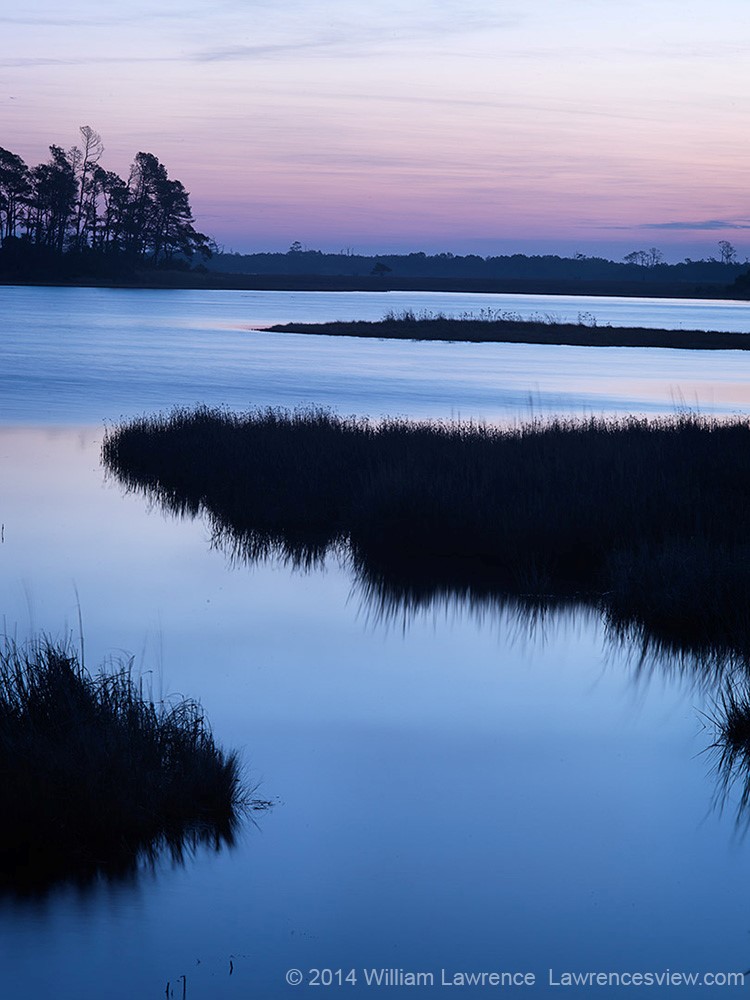
Sunrise at Chincoteague National Wildlife Refuge © 2014 William Lawrence
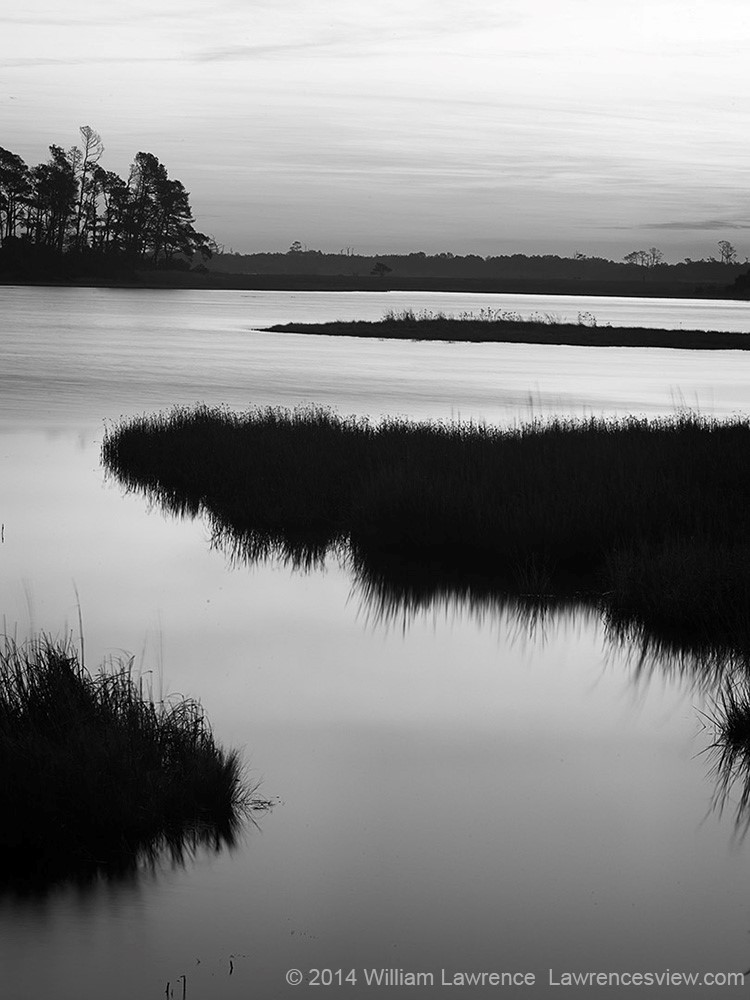
Sunrise at Chincoteague National Wildlife Refuge © 2014 William Lawrence
Finally, at a point when the light was interesting across the horizon, he put on a moderately wide lens and shot a diptych to give a panoramic view across the marsh.
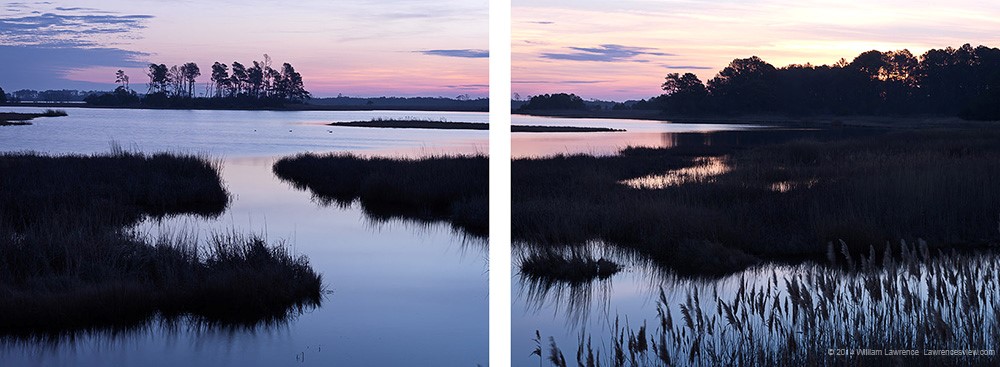
Sunrise at Chincoteague National Wildlife Refuge © 2014 William Lawrence
So, the next time you’re out photographing a wonderful scene, and you’ve got what you think is the perfect shot in camera, step back for a moment and ask yourself “what other ways could I be photographing this scene?” Try a different lens (or zoom in/out if you have a zoom lens)? Change the camera orientation? Go photograph it from over there? Particularly if you are traveling to photograph, you don’t want to wind up looking at your photos after the fact and saying “why didn’t I try (zooming in/zooming out/ moving left/etc)?” So make sure you work the scene while you are there.
If you found the idea of working the scene helpful, it’s one of the concepts Bill and I talk about our landscape photography workshops. Our next workshops are Winter’s Beauty at Chincoteague and Assaeteague on February 5-7, and Springtime in the South: Savannah, Charleston and the South Carolina Low Country on March 20-26. We’d love to have you join us for one of our workshops.










































